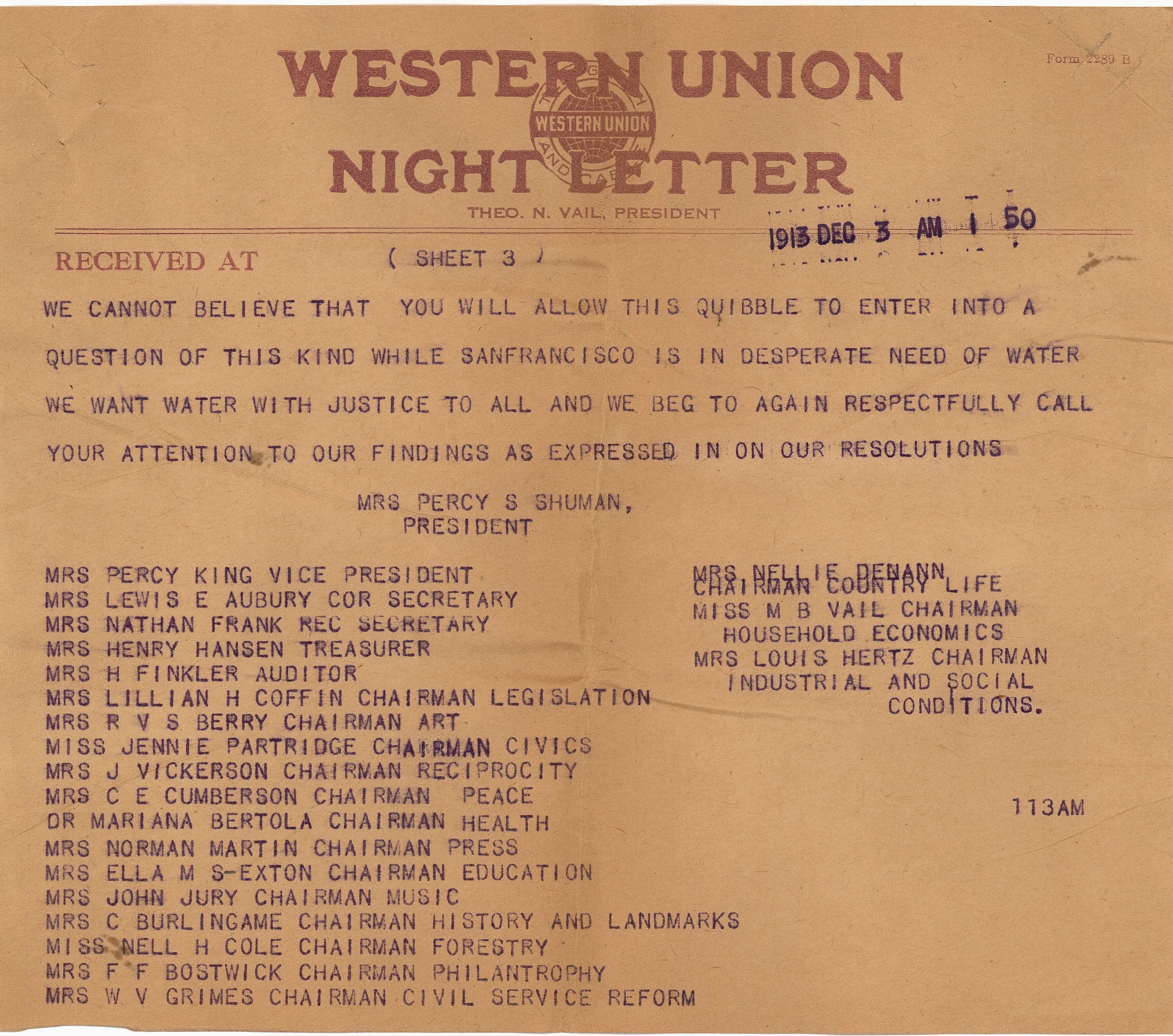Hetch Hetchy Valley: Build a Dam or Preserve the Valley
Weighing the Evidence
All documents and text associated with this activity are printed below, followed by a worksheet for student responses.Introduction
Between 1908 and 1913, Congress debated whether to make a water resource available or preserve a wilderness when the growing city of San Francisco, California, proposed building a dam in the Hetch Hetchy Valley to provide a steady water supply. The Hetch Hetchy Valley was within Yosemite National Park and protected by the Federal Government, leaving it up to Congress to decide the valley’s fate. National opinion divided between giving San Francisco the right to dam the valley and preserving the valley from development.Hundreds of individuals and organizations from across the country submitted petitions to Congress regarding the valley. These petitions, some of which are included below, bear witness to the birth of environmental activism as citizens weighed in, expressing multiple opinions about the proper use of National Park land and the relationship between local interests and national values.
Read and analyze the following petitions, resolutions, and telegrams sent to the United States Senate related to the issue. Pay attention to the message and the messengers, particularly the difference between the opinions of residents of San Francisco and other groups. Analyze each document and move it to to the scale according to how strongly you think it supports one side or the other.
Class:
Worksheet
Hetch Hetchy Valley: Build a Dam or Preserve the Valley
Weighing the Evidence
Examine the documents and text included in this activity. Consider how each document does or does not support two opposing interpretations or conclusions. Fill in the topic or interpretations if they are not provided. To show how the documents support the different interpretations, enter the corresponding document number into the boxes near the interpretation. Write your conclusion response in the space provided.The Hetch Hetchy Valley should be developed with a dam to benefit the residents of San Francisco.
Hetch Hetchy Valley: Build a Dam or Preserve a Wilderness
The Hetch Hetchy Valley should be preserved to maintain the natural beauty of Yosemite National Park.
Activity Element
Petition Against the So-Called Hetch Hetchy Bill (H.R. 7207) from the University of Oklahoma
Page 1
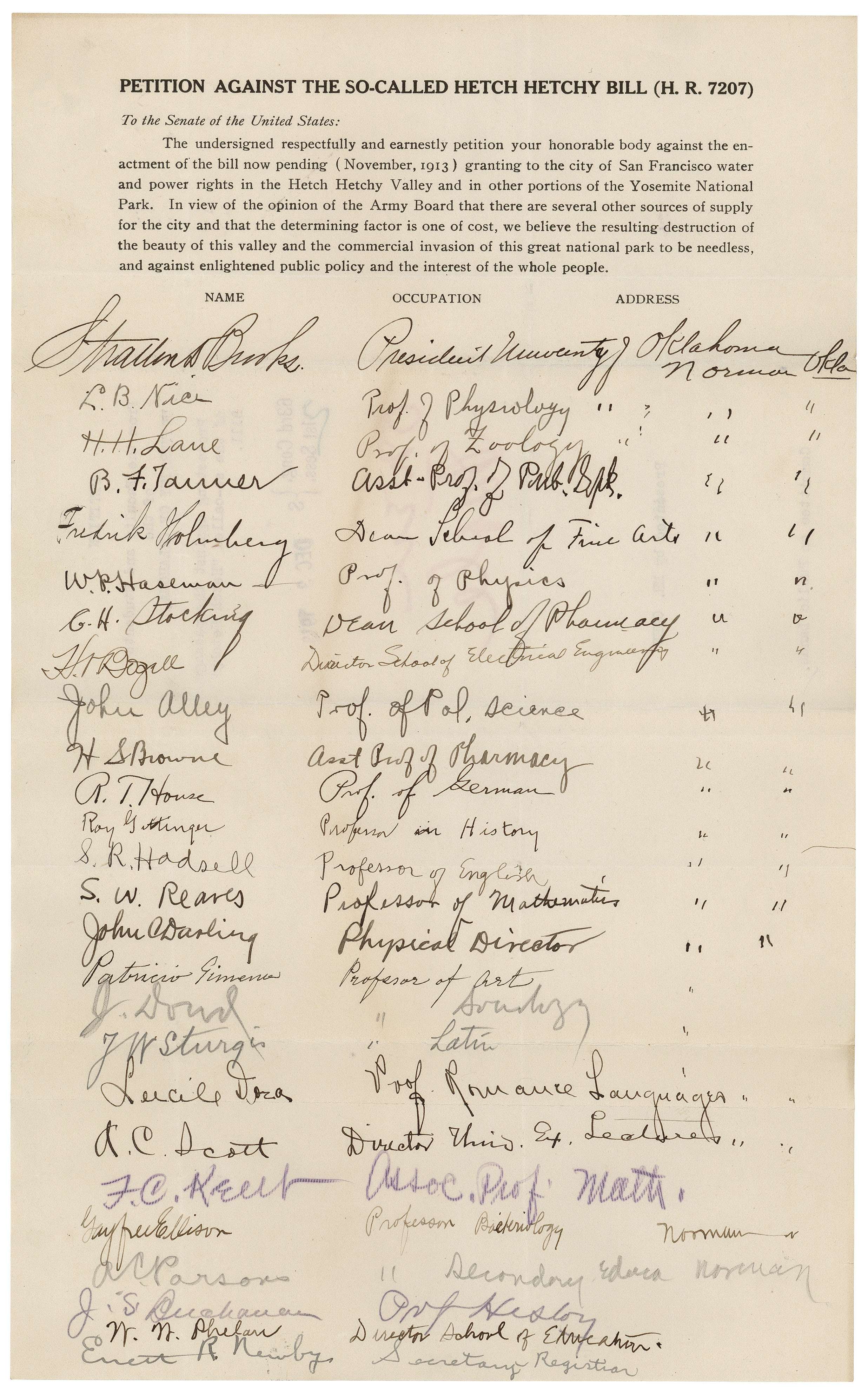
Activity Element
Petition from the American Scenic and Historic Preservation Society against the Raker Bill
Page 1
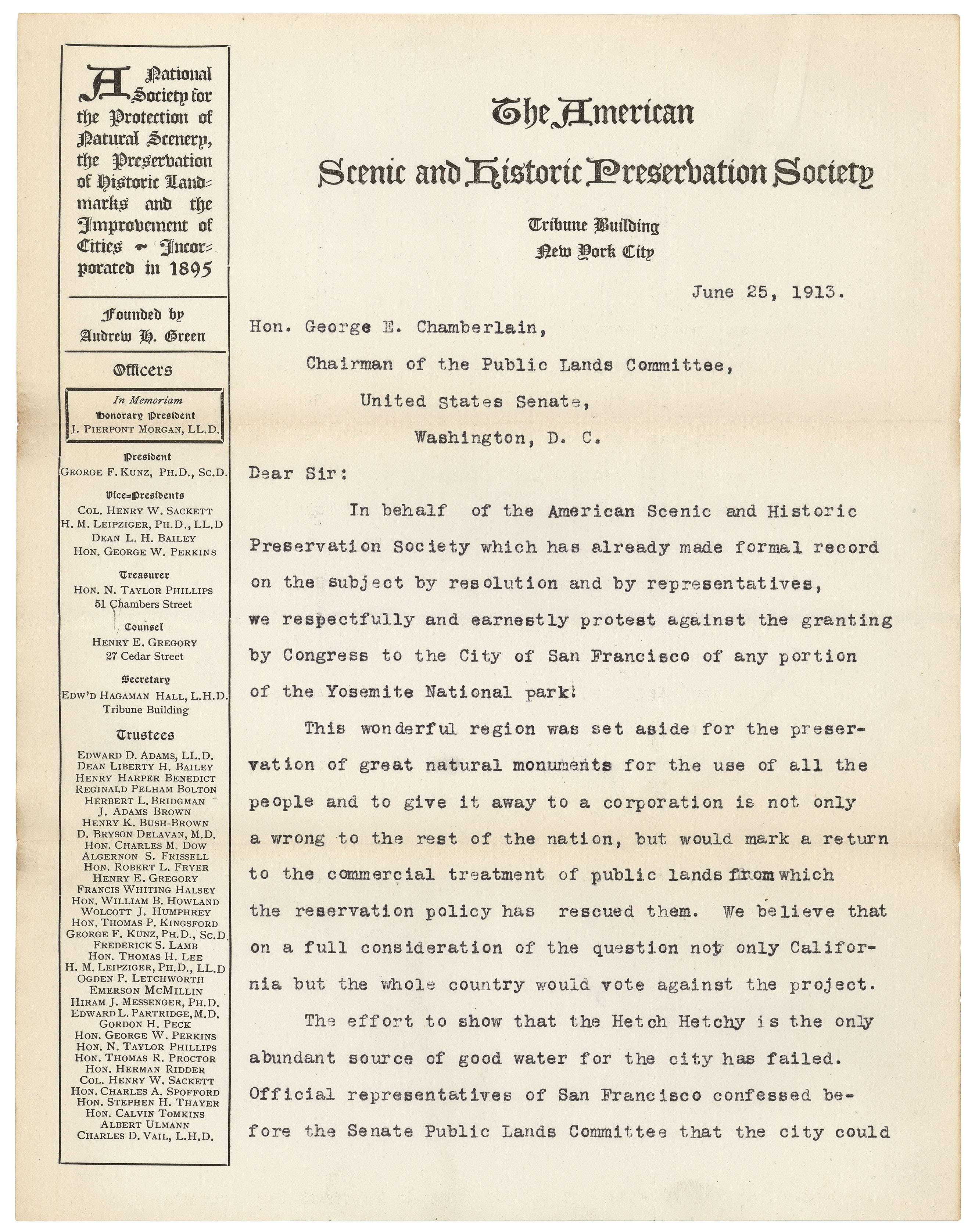
Activity Element
Petition from San Francisco Swedish Clubs Supporting the Raker Bill
Page 1
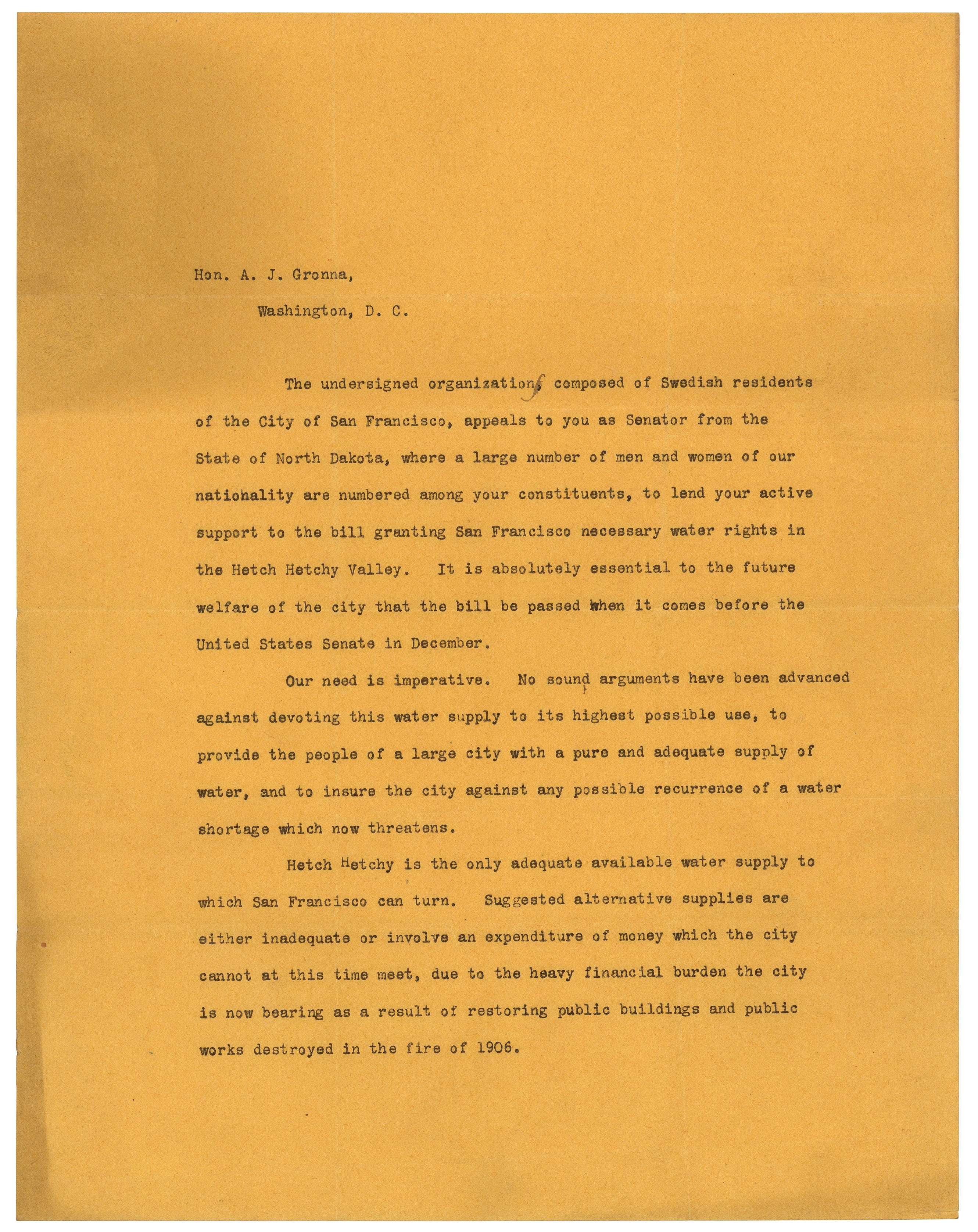
Activity Element
Petition from the Hypatia Women’s Club of San Francisco in favor of Granting San Francisco Water Rights for Lake Eleanor and Hetch Hetchy
Page 1
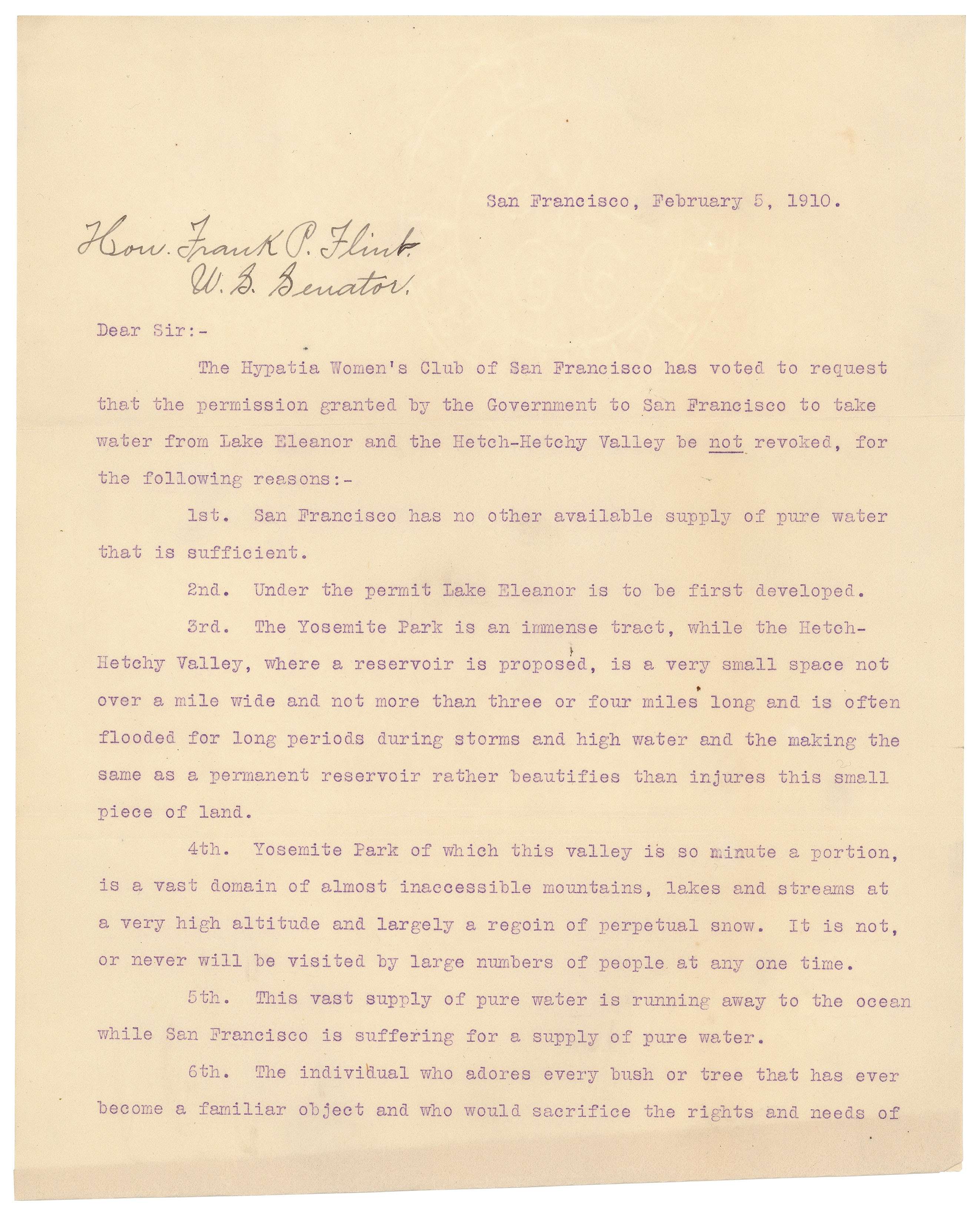
Activity Element
Petition from the Society for the Preservation of National Parks against Granting San Francisco the Hetch Hetchy Valley
Page 1
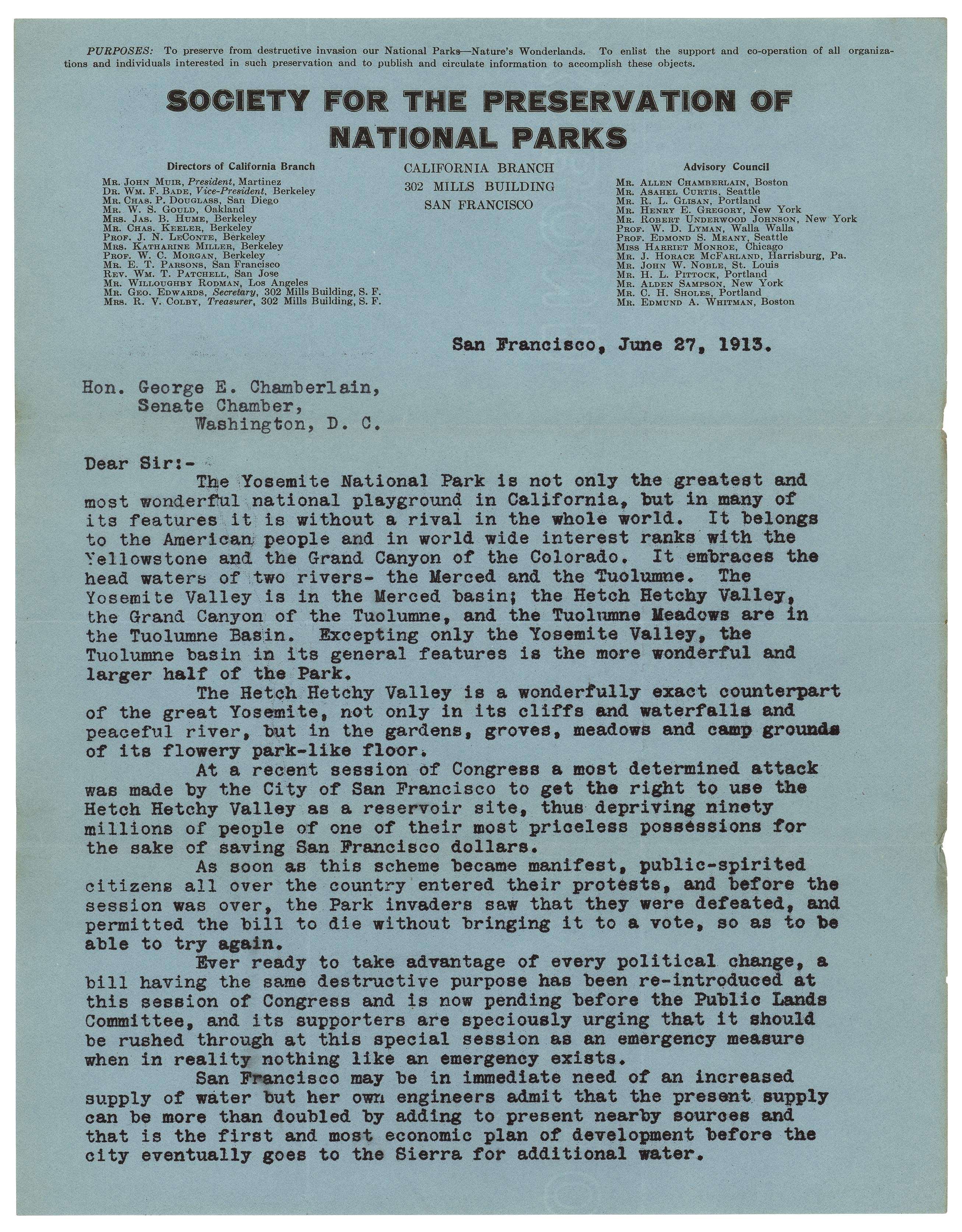
Activity Element
Petition from the Widows and Orphans and Mutual Aid Associations, Inc., of the San Francisco Fire Department Supporting the Raker Bill
Page 1
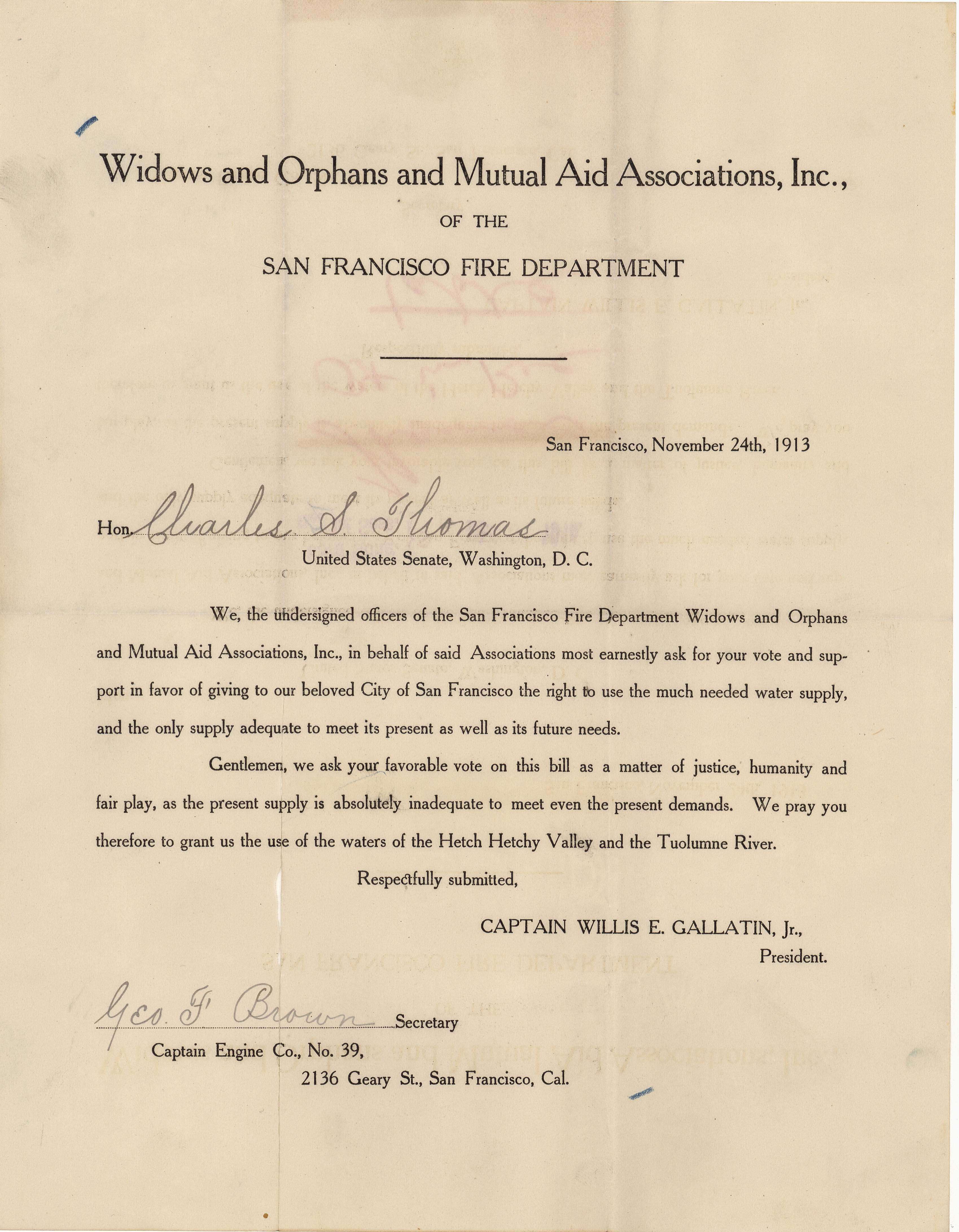
Activity Element
Resolution by the Massachusetts State Federation of Women’s Clubs against the Raker Bill
Page 1
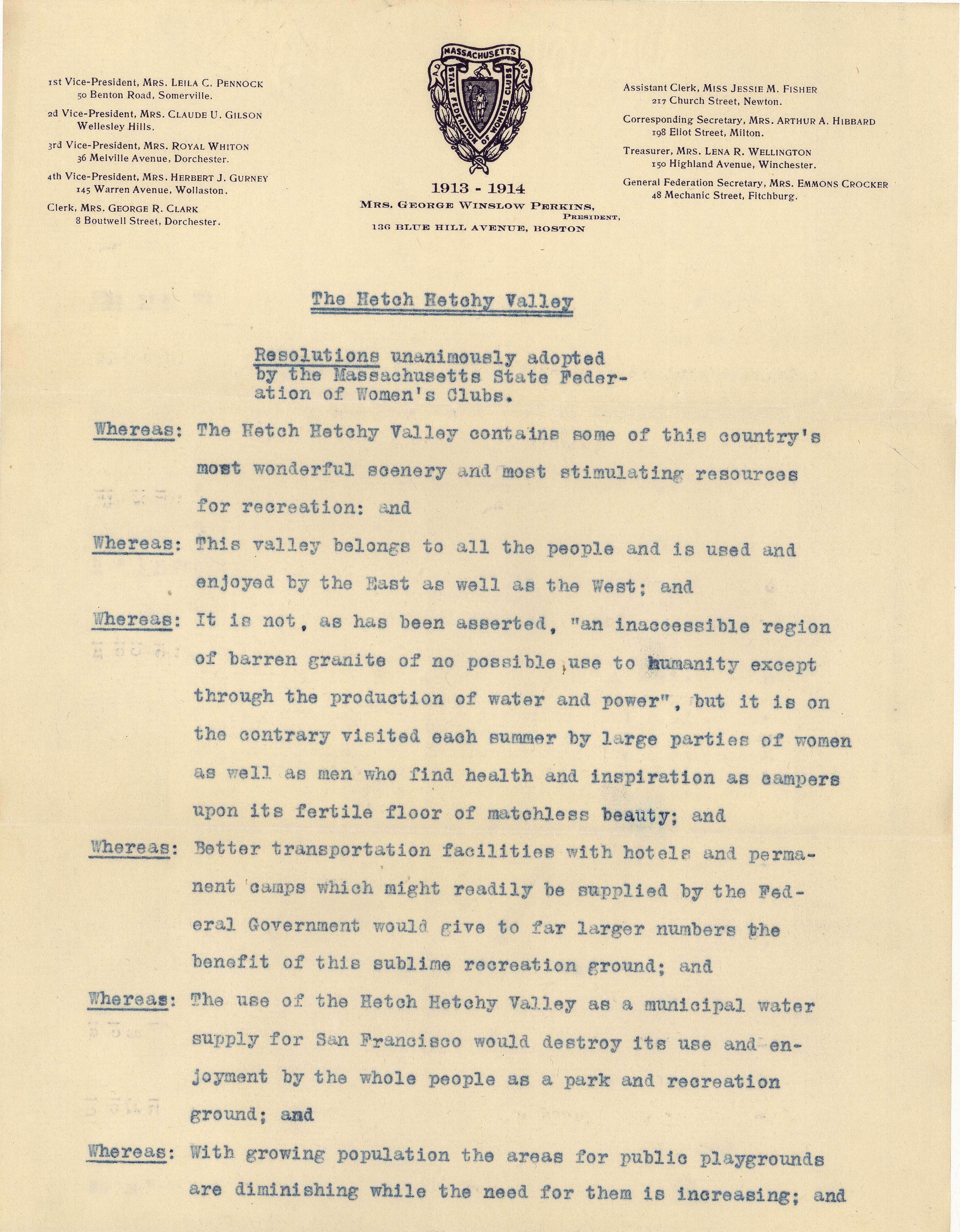
Activity Element
Resolution from the Augusta, Hallowell, and Gardner Central Labor Union of Maine Supporting the Raker Bill
Page 1
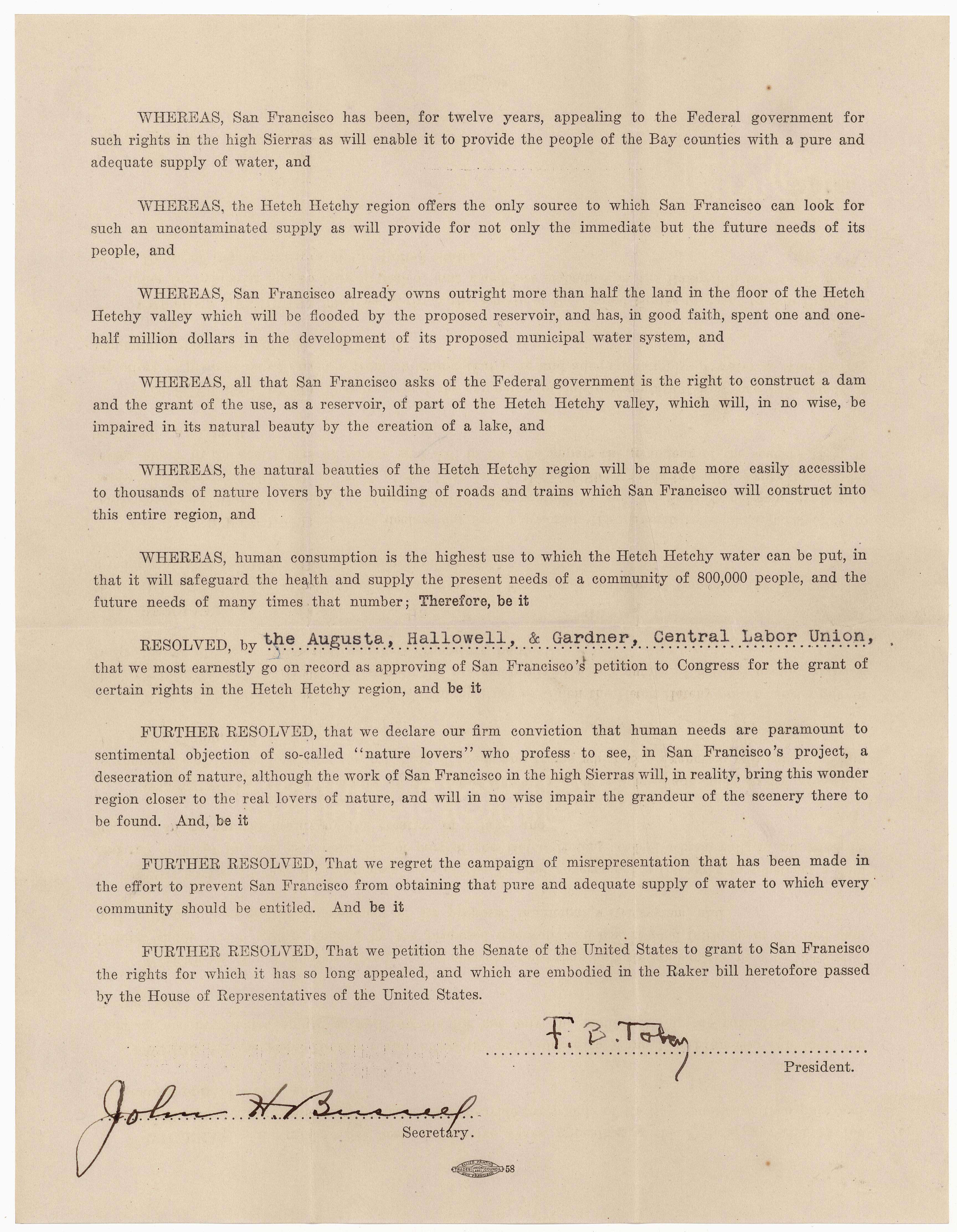
Activity Element
Resolution from the Graffort Club of Portsmouth, New Hampshire, against Granting San Francisco the Hetch Hetchy Valley
Page 1
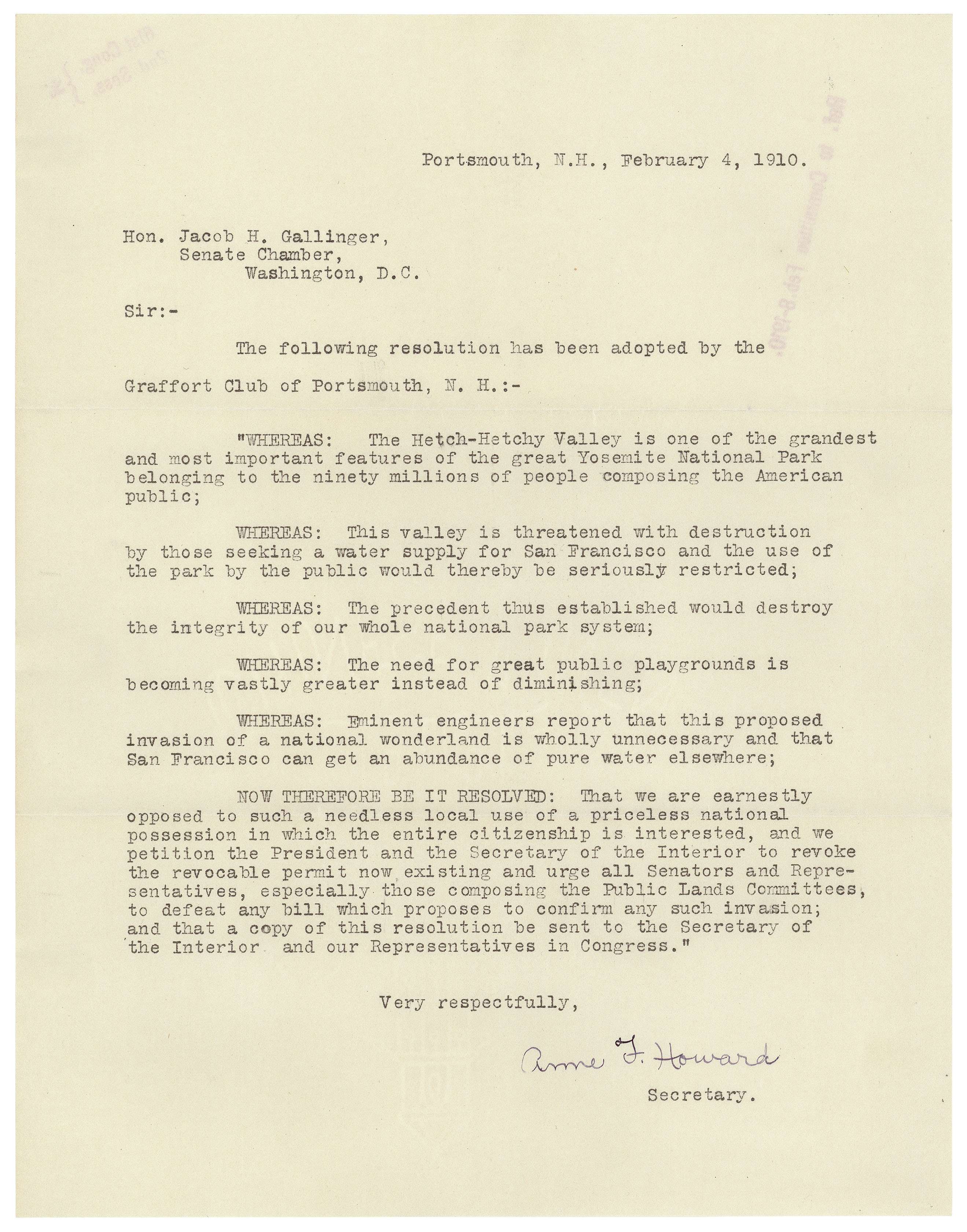
Activity Element
Resolution, "Protest Against Diversion of Waters from Lands Requiring Irrigation," from Citizens of Merced and Stanislaus Counties, California
Page 1

Activity Element
San Francisco Examiner "Petition to the Senate of the United States" Supporting the Raker Bill
Page 1
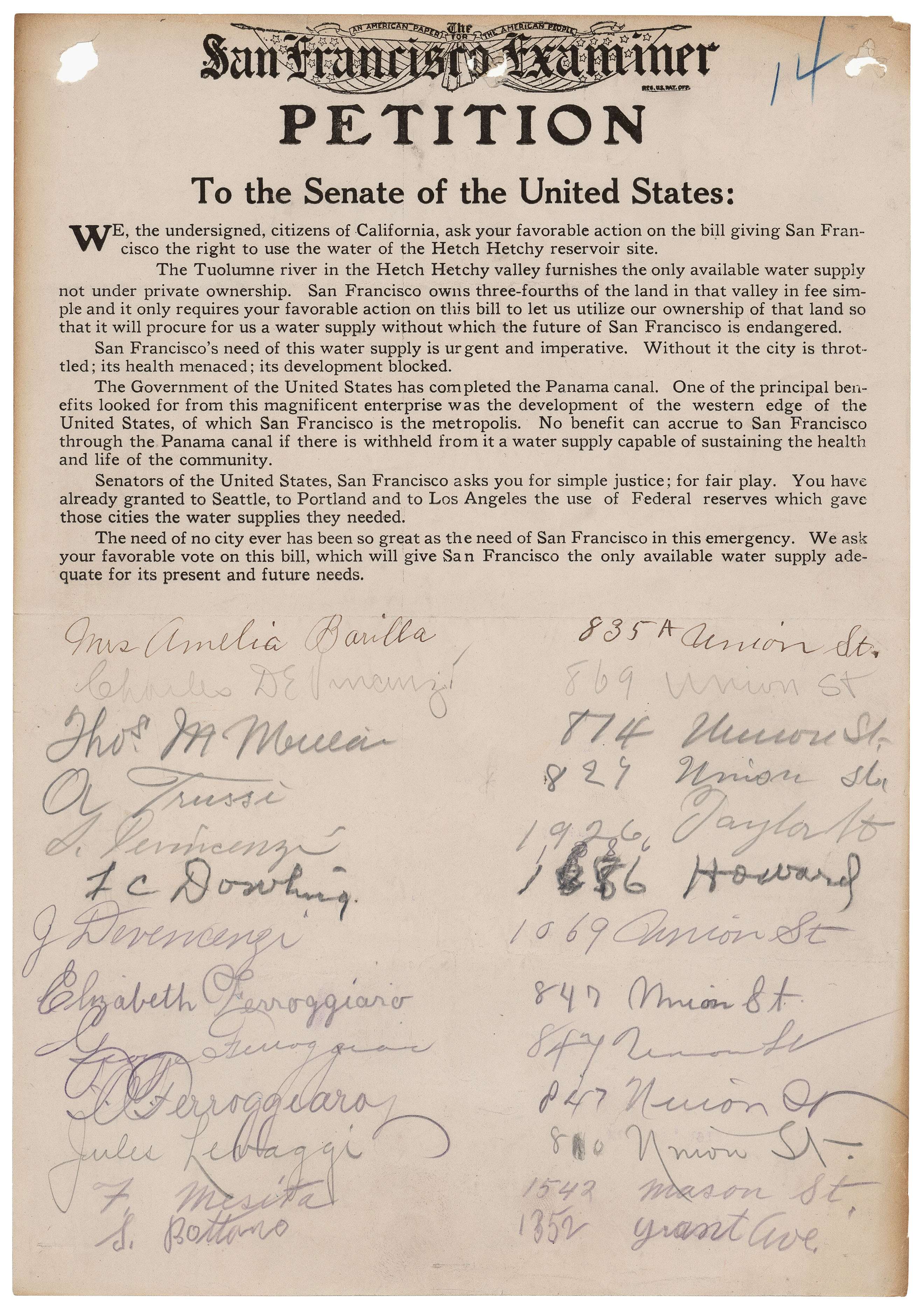
Activity Element
Telegram from the San Francisco Council No. 615, Knights of Columbus, Supporting the Raker Bill
Page 1
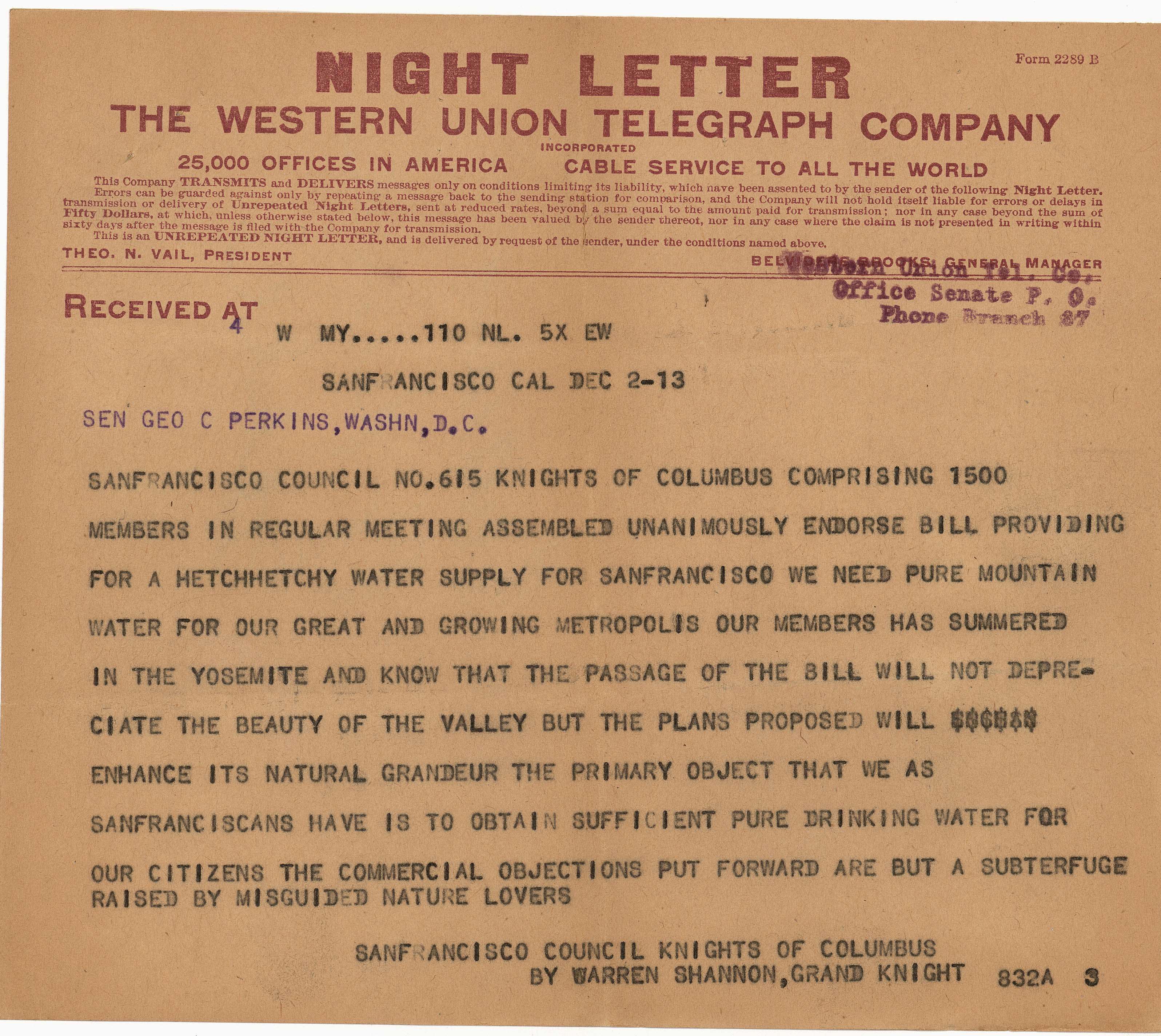
Activity Element
Telegram from the Executive Board of the San Francisco District of the California Federation of Women`s Clubs Supporting the Raker Bill
Page 2
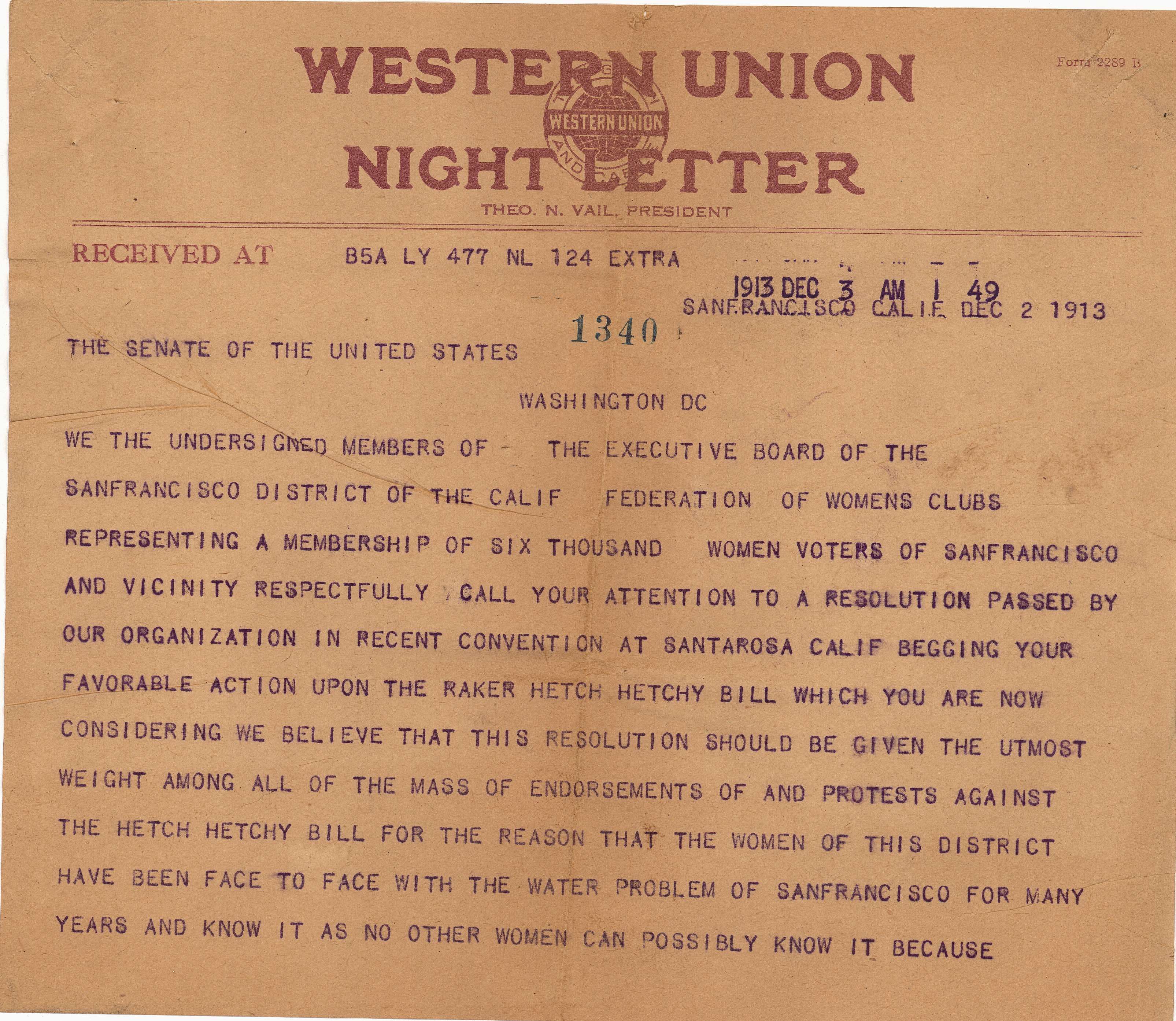
Conclusion
Hetch Hetchy Valley: Build a Dam or Preserve the Valley
Weighing the Evidence
Answer the following questions in preparation for a class discussion:- Which document presented the strongest argument for or against building the dam?
- Was the evidence stronger for the dam or against the dam?
- Which of the positions expressed in the Hetch Hetchy debate a century ago are still relevant in decisions between development and preservation today?
- What local and national issues pose a choice similar to that in the Hetch Hetchy debate?
- How might understanding the debate over the Hetch Hetchy Valley inform environmental debates today?
Your Response
Document
Petition Against the So-Called Hetch Hetchy Bill (H.R. 7207) from the University of Oklahoma
1913
Between 1908 and 1913, Congress debated whether to make a water resource available or preserve a wilderness when the growing city of San Francisco, California proposed building a dam in the Hetch Hetchy Valley to provide a steady water supply. The Hetch Hetchy Valley was within Yosemite National Park and protected by the federal government, leaving it up to Congress to decide the valley’s fate. National opinion divided between giving San Francisco the right to dam the valley and preserving the valley from development.
At the heart of the debate was the conflict between conservationists, who held that the environment should be used in a conscientious manner to benefit society, and preservationists, who believed that nature should be protected, saved from human interference. Siding with the conservationists, San Francisco citizens argued that the reservoir was necessary for the health of their city. On the other side, preservationists, led by John Muir, argued that Congress should protect the Hetch Hetchy Valley from destruction. Muir and his allies believed that nature should be enjoyed for its beauty, and not merely used for its resources.
Hundreds of individuals and organizations from across the country submitted petitions to Congress regarding the valley. These petitions, some of which are included below, bear witness to the birth of environmental activism as citizens weighed in, expressing multiple opinions about the proper use of National Park land and the relationship between local interests and national values.
In the end, Congress passed legislation that enabled the creation of a dam in the Hetch Hetchy Valley. President Woodrow Wilson signed the bill into law on December 19, 1913. Although the preservationists lost this battle, the damming of the Hetch Hetchy Valley raised public awareness about the importance of preserving nature, and helped justify the creation of the National Park Service in 1916.
Petition Against the So-Called Hetch Hetchy Bill (H.R. 7207) from the University of Oklahoma
Page 1
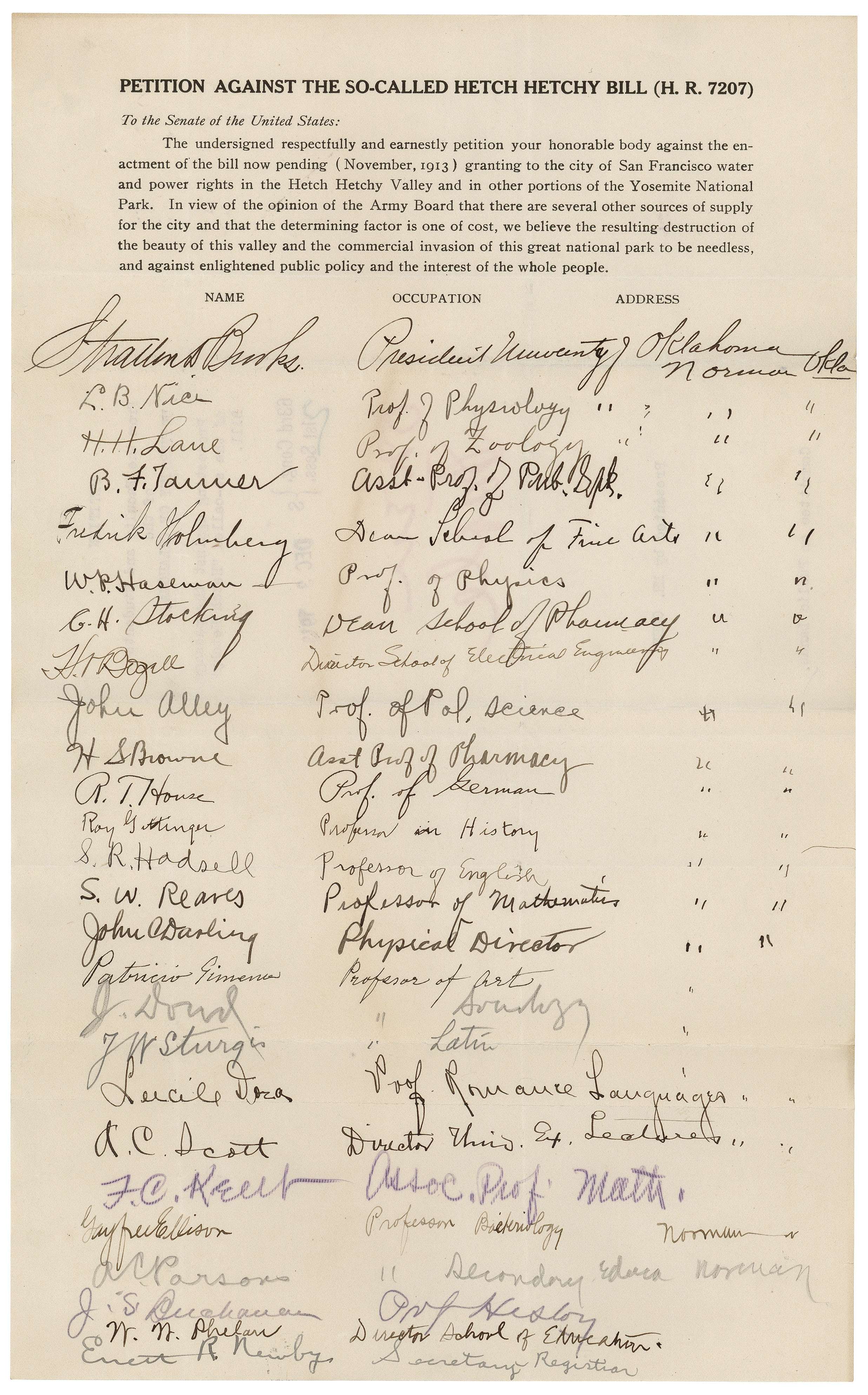
Document
Petition from the American Scenic and Historic Preservation Society against the Raker Bill
6/25/1913
Between 1908 and 1913, Congress debated whether to make a water resource available or preserve a wilderness when the growing city of San Francisco, California proposed building a dam in the Hetch Hetchy Valley to provide a steady water supply. The Hetch Hetchy Valley was within Yosemite National Park and protected by the federal government, leaving it up to Congress to decide the valley’s fate. National opinion divided between giving San Francisco the right to dam the valley and preserving the valley from development.
At the heart of the debate was the conflict between conservationists, who held that the environment should be used in a conscientious manner to benefit society, and preservationists, who believed that nature should be protected, saved from human interference. Siding with the conservationists, San Francisco citizens argued that the reservoir was necessary for the health of their city. On the other side, preservationists, led by John Muir, argued that Congress should protect the Hetch Hetchy Valley from destruction. Muir and his allies believed that nature should be enjoyed for its beauty, and not merely used for its resources.
Hundreds of individuals and organizations from across the country submitted petitions to Congress regarding the valley. These petitions, some of which are included below, bear witness to the birth of environmental activism as citizens weighed in, expressing multiple opinions about the proper use of National Park land and the relationship between local interests and national values.
In the end, Congress passed legislation that enabled the creation of a dam in the Hetch Hetchy Valley. President Woodrow Wilson signed the bill into law on December 19, 1913. Although the preservationists lost this battle, the damming of the Hetch Hetchy Valley raised public awareness about the importance of preserving nature, and helped justify the creation of the National Park Service in 1916.
Petition from the American Scenic and Historic Preservation Society against the Raker Bill
Page 1
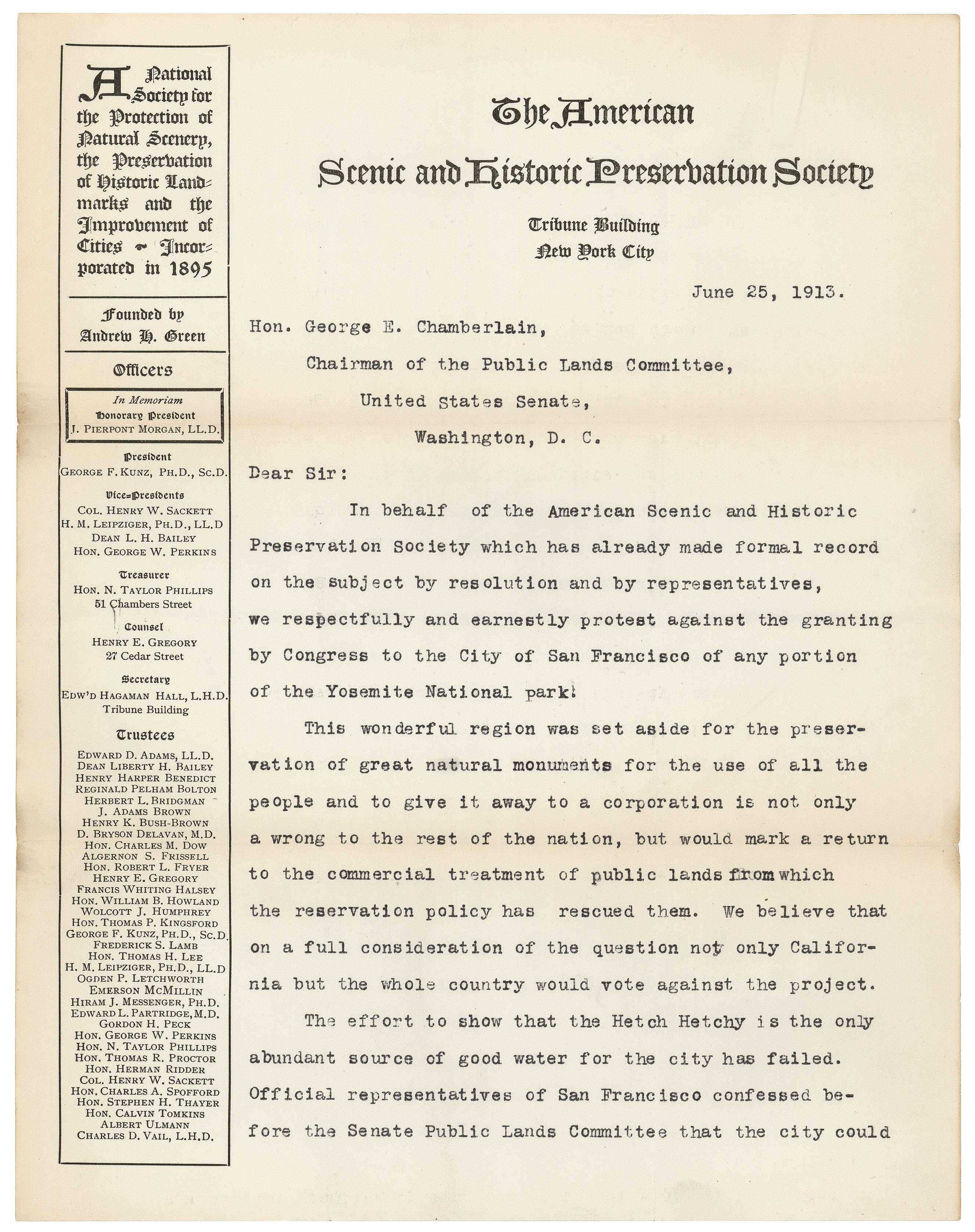
Petition from the American Scenic and Historic Preservation Society against the Raker Bill
Page 2
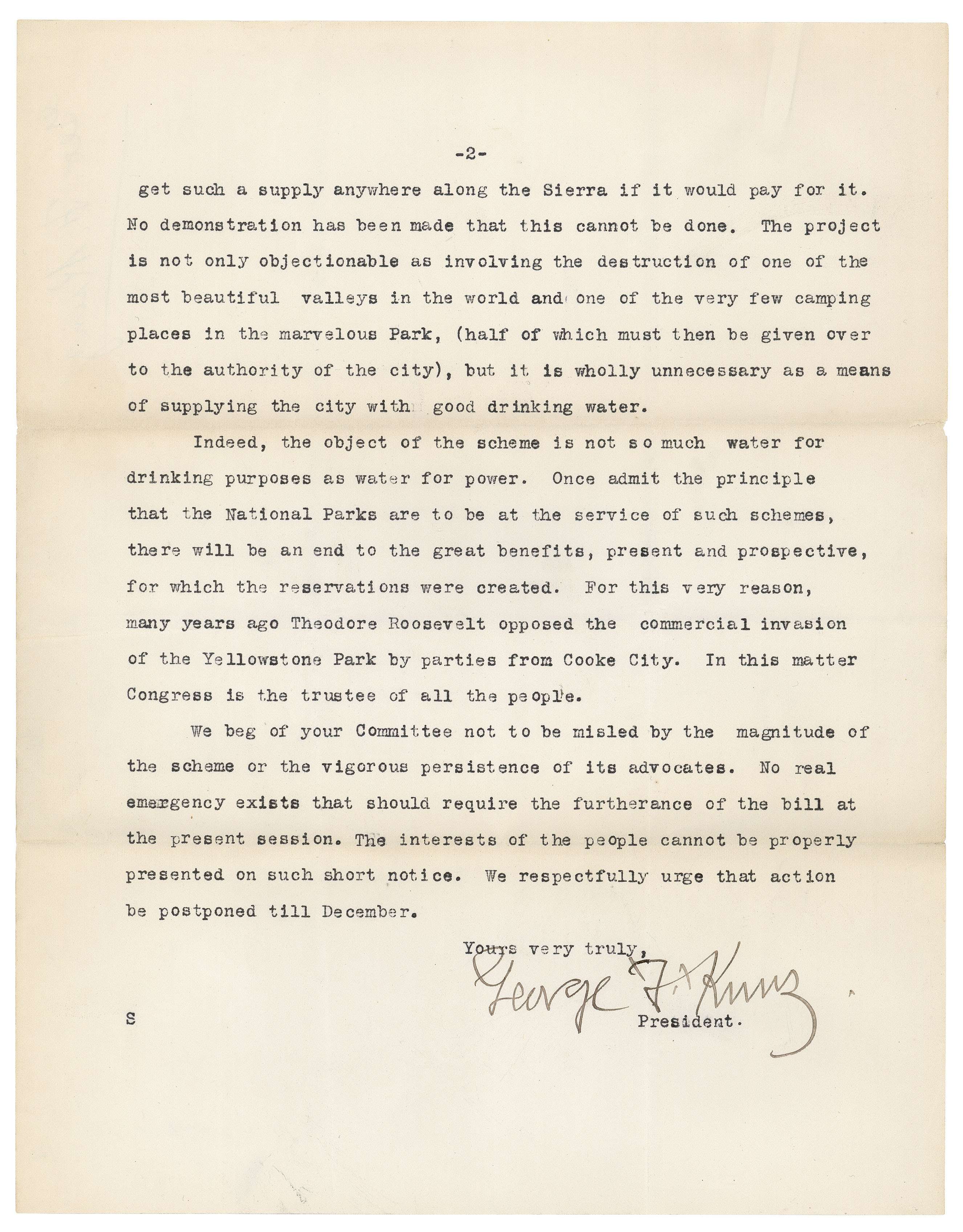
Document
Petition from San Francisco Swedish Clubs Supporting the Raker Bill
1913
Between 1908 and 1913, Congress debated whether to make a water resource available or preserve a wilderness when the growing city of San Francisco, California proposed building a dam in the Hetch Hetchy Valley to provide a steady water supply. The Hetch Hetchy Valley was within Yosemite National Park and protected by the federal government, leaving it up to Congress to decide the valley’s fate. National opinion divided between giving San Francisco the right to dam the valley and preserving the valley from development.
At the heart of the debate was the conflict between conservationists, who held that the environment should be used in a conscientious manner to benefit society, and preservationists, who believed that nature should be protected, saved from human interference. Siding with the conservationists, San Francisco citizens argued that the reservoir was necessary for the health of their city. On the other side, preservationists, led by John Muir, argued that Congress should protect the Hetch Hetchy Valley from destruction. Muir and his allies believed that nature should be enjoyed for its beauty, and not merely used for its resources.
Hundreds of individuals and organizations from across the country submitted petitions to Congress regarding the valley. These petitions, some of which are included below, bear witness to the birth of environmental activism as citizens weighed in, expressing multiple opinions about the proper use of National Park land and the relationship between local interests and national values.
In the end, Congress passed legislation that enabled the creation of a dam in the Hetch Hetchy Valley. President Woodrow Wilson signed the bill into law on December 19, 1913. Although the preservationists lost this battle, the damming of the Hetch Hetchy Valley raised public awareness about the importance of preserving nature, and helped justify the creation of the National Park Service in 1916.
Petition from San Francisco Swedish Clubs Supporting the Raker Bill
Page 1
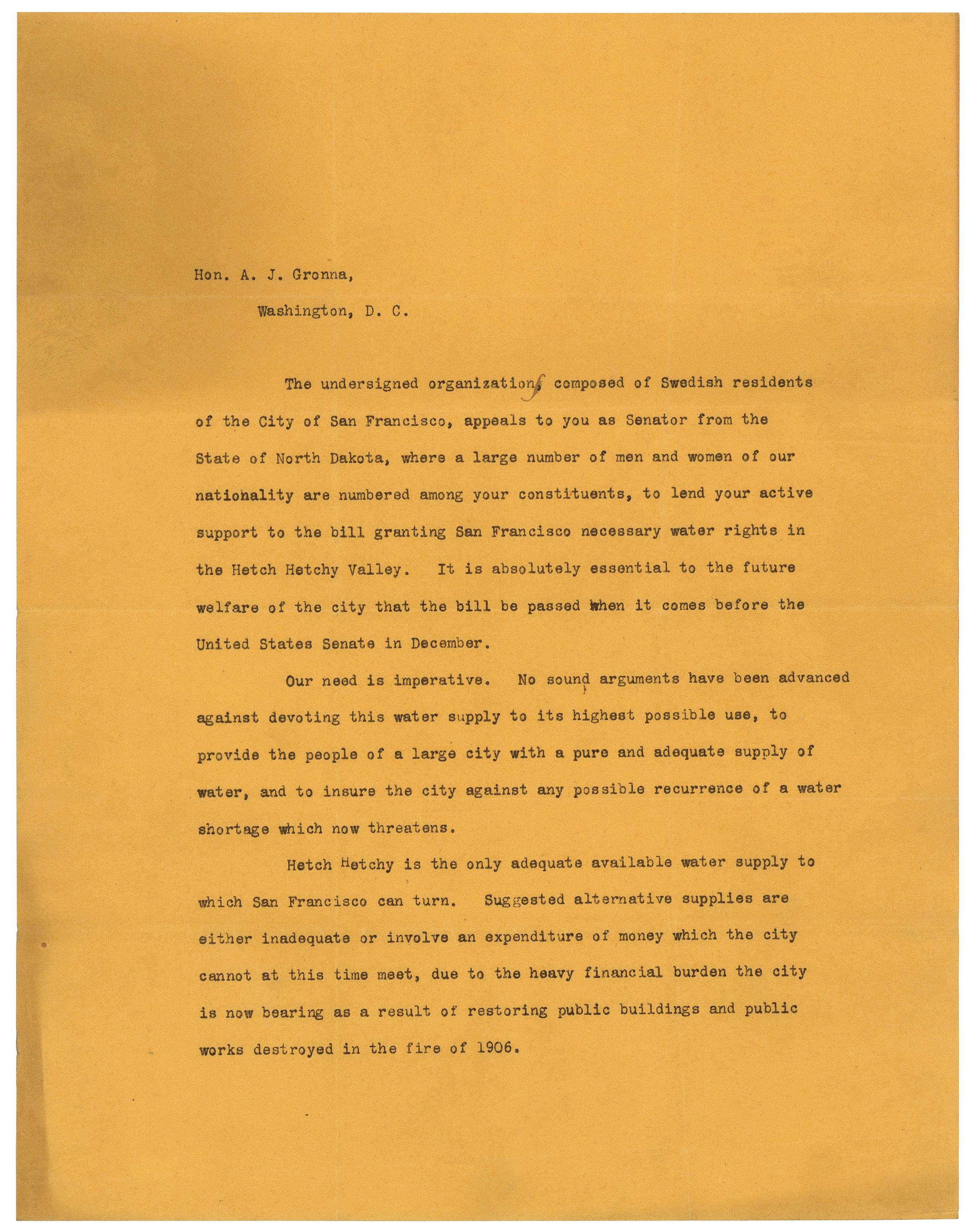
Petition from San Francisco Swedish Clubs Supporting the Raker Bill
Page 2
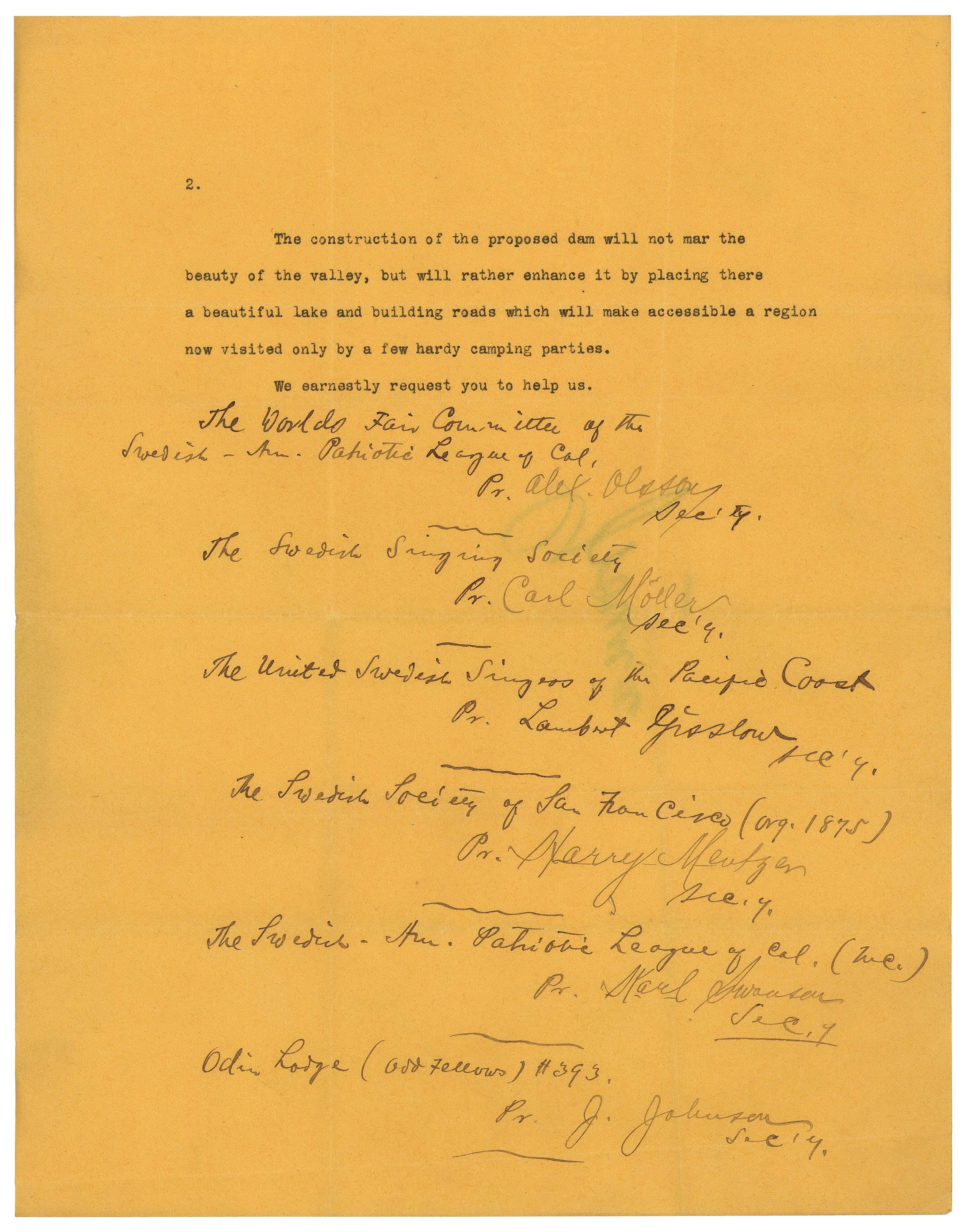
Document
Petition from the Hypatia Women’s Club of San Francisco in favor of Granting San Francisco Water Rights for Lake Eleanor and Hetch Hetchy
2/5/1910
Between 1908 and 1913, Congress debated whether to make a water resource available or preserve a wilderness when the growing city of San Francisco, California proposed building a dam in the Hetch Hetchy Valley to provide a steady water supply. The Hetch Hetchy Valley was within Yosemite National Park and protected by the federal government, leaving it up to Congress to decide the valley’s fate. National opinion divided between giving San Francisco the right to dam the valley and preserving the valley from development.
At the heart of the debate was the conflict between conservationists, who held that the environment should be used in a conscientious manner to benefit society, and preservationists, who believed that nature should be protected, saved from human interference. Siding with the conservationists, San Francisco citizens argued that the reservoir was necessary for the health of their city. On the other side, preservationists, led by John Muir, argued that Congress should protect the Hetch Hetchy Valley from destruction. Muir and his allies believed that nature should be enjoyed for its beauty, and not merely used for its resources.
Hundreds of individuals and organizations from across the country submitted petitions to Congress regarding the valley. These petitions, some of which are included below, bear witness to the birth of environmental activism as citizens weighed in, expressing multiple opinions about the proper use of National Park land and the relationship between local interests and national values.
In the end, Congress passed legislation that enabled the creation of a dam in the Hetch Hetchy Valley. President Woodrow Wilson signed the bill into law on December 19, 1913. Although the preservationists lost this battle, the damming of the Hetch Hetchy Valley raised public awareness about the importance of preserving nature, and helped justify the creation of the National Park Service in 1916.
Petition from the Hypatia Women’s Club of San Francisco in favor of Granting San Francisco Water Rights for Lake Eleanor and Hetch Hetchy
Page 1
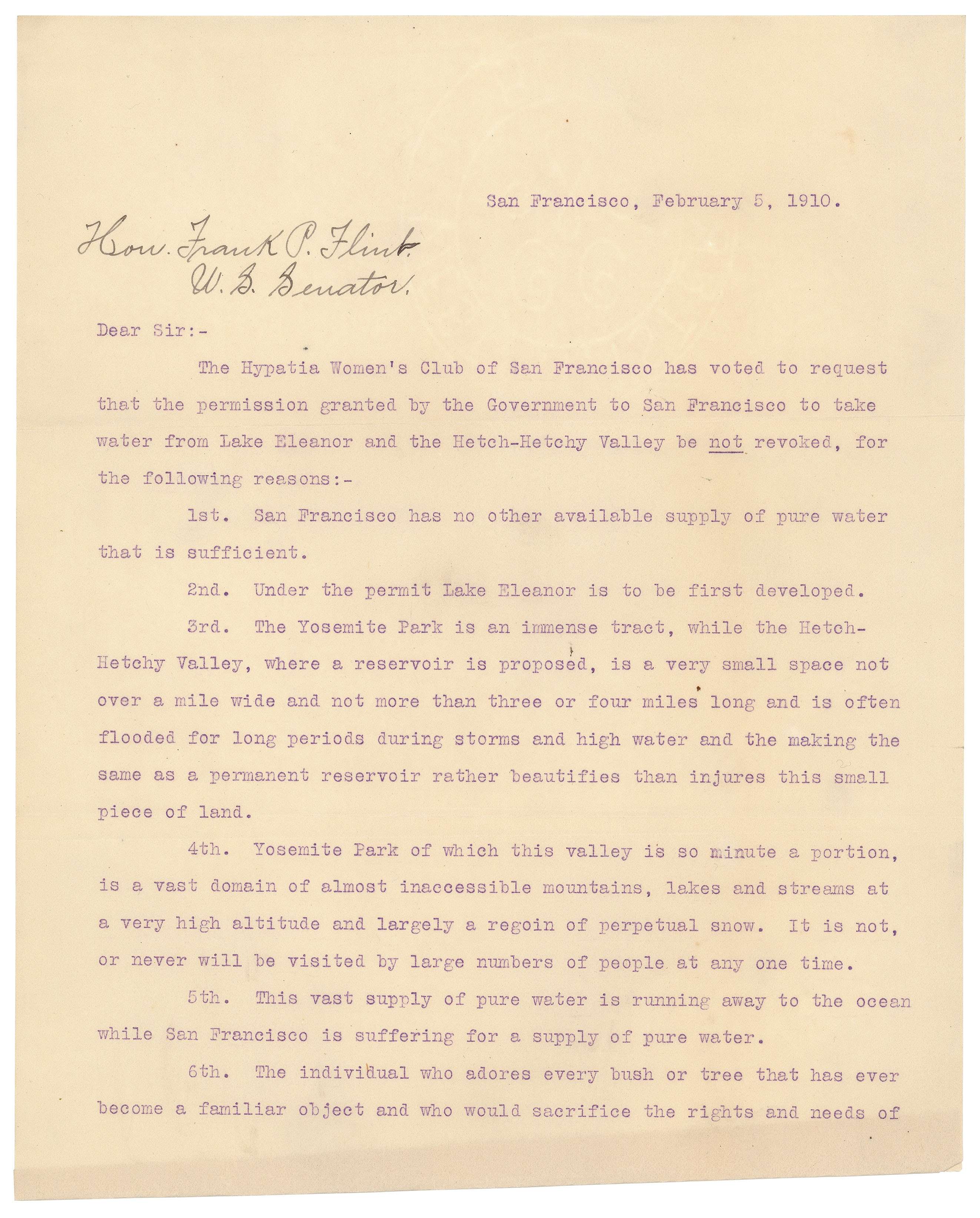
Petition from the Hypatia Women’s Club of San Francisco in favor of Granting San Francisco Water Rights for Lake Eleanor and Hetch Hetchy
Page 2

Document
Petition from the Society for the Preservation of National Parks against Granting San Francisco the Hetch Hetchy Valley
6/27/1913
Between 1908 and 1913, Congress debated whether to make a water resource available or preserve a wilderness when the growing city of San Francisco, California proposed building a dam in the Hetch Hetchy Valley to provide a steady water supply. The Hetch Hetchy Valley was within Yosemite National Park and protected by the federal government, leaving it up to Congress to decide the valley’s fate. National opinion divided between giving San Francisco the right to dam the valley and preserving the valley from development.
At the heart of the debate was the conflict between conservationists, who held that the environment should be used in a conscientious manner to benefit society, and preservationists, who believed that nature should be protected, saved from human interference. Siding with the conservationists, San Francisco citizens argued that the reservoir was necessary for the health of their city. On the other side, preservationists, led by John Muir, argued that Congress should protect the Hetch Hetchy Valley from destruction. Muir and his allies believed that nature should be enjoyed for its beauty, and not merely used for its resources.
Hundreds of individuals and organizations from across the country submitted petitions to Congress regarding the valley. These petitions, some of which are included below, bear witness to the birth of environmental activism as citizens weighed in, expressing multiple opinions about the proper use of National Park land and the relationship between local interests and national values.
In the end, Congress passed legislation that enabled the creation of a dam in the Hetch Hetchy Valley. President Woodrow Wilson signed the bill into law on December 19, 1913. Although the preservationists lost this battle, the damming of the Hetch Hetchy Valley raised public awareness about the importance of preserving nature, and helped justify the creation of the National Park Service in 1916.
Petition from the Society for the Preservation of National Parks against Granting San Francisco the Hetch Hetchy Valley
Page 1
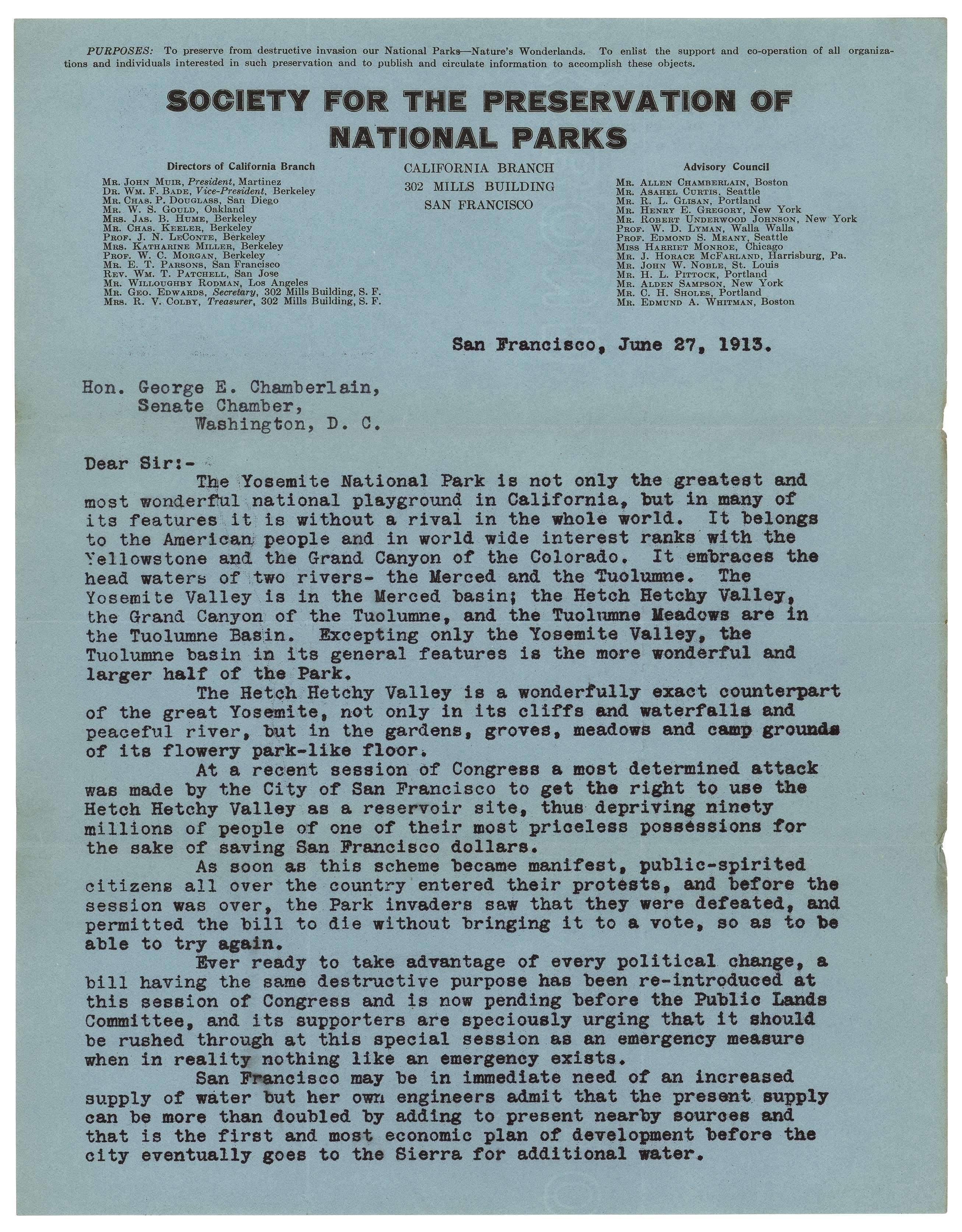
Petition from the Society for the Preservation of National Parks against Granting San Francisco the Hetch Hetchy Valley
Page 2
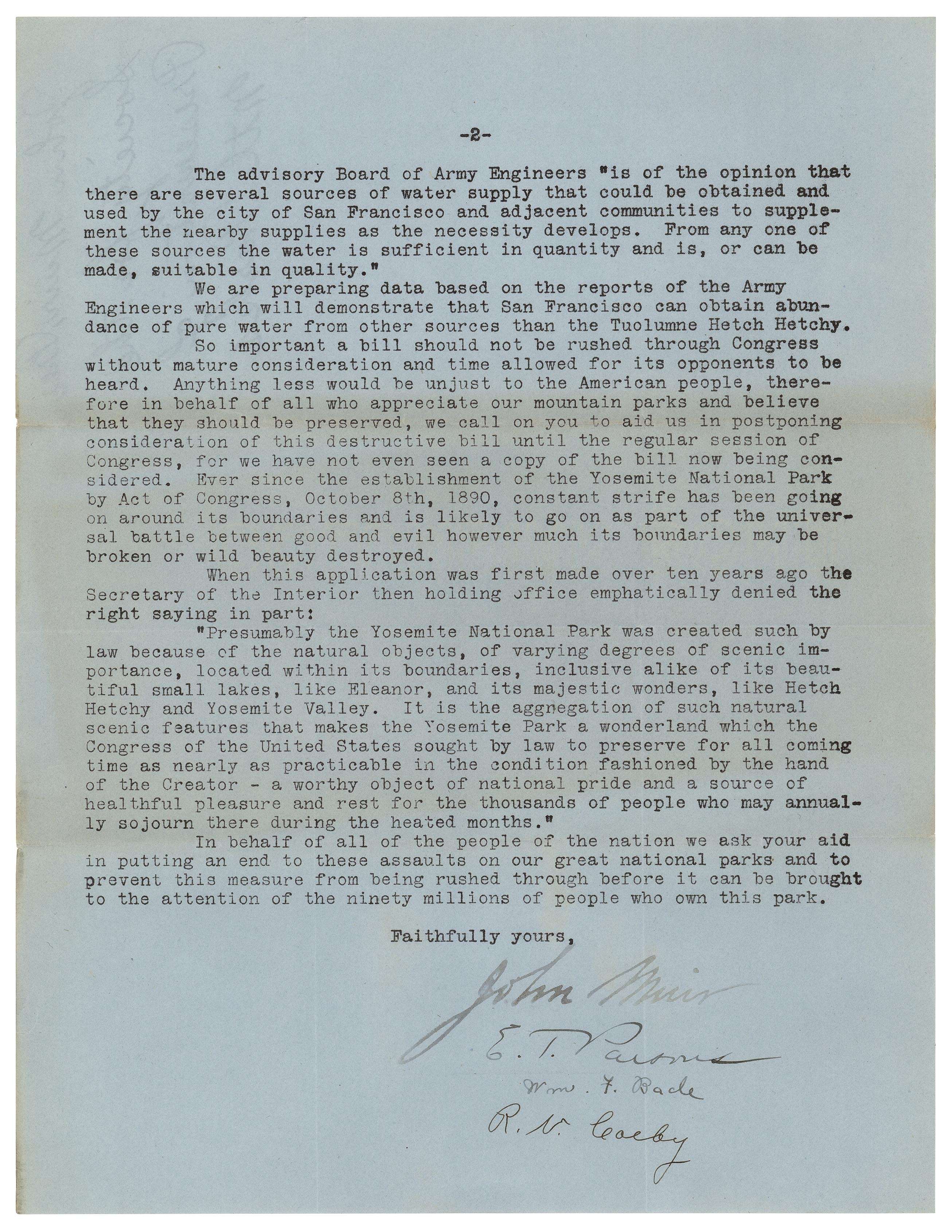
Document
Petition from the Widows and Orphans and Mutual Aid Associations, Inc., of the San Francisco Fire Department Supporting the Raker Bill
1913
Between 1908 and 1913, Congress debated whether to make a water resource available or preserve a wilderness when the growing city of San Francisco, California proposed building a dam in the Hetch Hetchy Valley to provide a steady water supply. The Hetch Hetchy Valley was within Yosemite National Park and protected by the federal government, leaving it up to Congress to decide the valley’s fate. National opinion divided between giving San Francisco the right to dam the valley and preserving the valley from development.
At the heart of the debate was the conflict between conservationists, who held that the environment should be used in a conscientious manner to benefit society, and preservationists, who believed that nature should be protected, saved from human interference. Siding with the conservationists, San Francisco citizens argued that the reservoir was necessary for the health of their city. On the other side, preservationists, led by John Muir, argued that Congress should protect the Hetch Hetchy Valley from destruction. Muir and his allies believed that nature should be enjoyed for its beauty, and not merely used for its resources.
Hundreds of individuals and organizations from across the country submitted petitions to Congress regarding the valley. These petitions, some of which are included below, bear witness to the birth of environmental activism as citizens weighed in, expressing multiple opinions about the proper use of National Park land and the relationship between local interests and national values.
In the end, Congress passed legislation that enabled the creation of a dam in the Hetch Hetchy Valley. President Woodrow Wilson signed the bill into law on December 19, 1913. Although the preservationists lost this battle, the damming of the Hetch Hetchy Valley raised public awareness about the importance of preserving nature, and helped justify the creation of the National Park Service in 1916.
Petition from the Widows and Orphans and Mutual Aid Associations, Inc., of the San Francisco Fire Department Supporting the Raker Bill
Page 1

Document
Resolution by the Massachusetts State Federation of Women’s Clubs against the Raker Bill
11/25/1913
At the heart of the debate was the conflict between conservationists, who held that the environment should be used in a conscientious manner to benefit society, and preservationists, who believed that nature should be protected, saved from human interference. Siding with the conservationists, San Francisco citizens argued that the reservoir was necessary for the health of their city. On the other side, preservationists, led by John Muir, argued that Congress should protect the Hetch Hetchy Valley from destruction. Muir and his allies believed that nature should be enjoyed for its beauty, and not merely used for its resources.
Hundreds of individuals and organizations from across the country submitted petitions to Congress regarding the valley. These petitions, some of which are included below, bear witness to the birth of environmental activism as citizens weighed in, expressing multiple opinions about the proper use of National Park land and the relationship between local interests and national values.
In the end, Congress passed legislation that enabled the creation of a dam in the Hetch Hetchy Valley. President Woodrow Wilson signed the bill into law on December 19, 1913. Although the preservationists lost this battle, the damming of the Hetch Hetchy Valley raised public awareness about the importance of preserving nature, and helped justify the creation of the National Park Service in 1916.
Resolution by the Massachusetts State Federation of Women’s Clubs against the Raker Bill
Page 1

Resolution by the Massachusetts State Federation of Women’s Clubs against the Raker Bill
Page 2
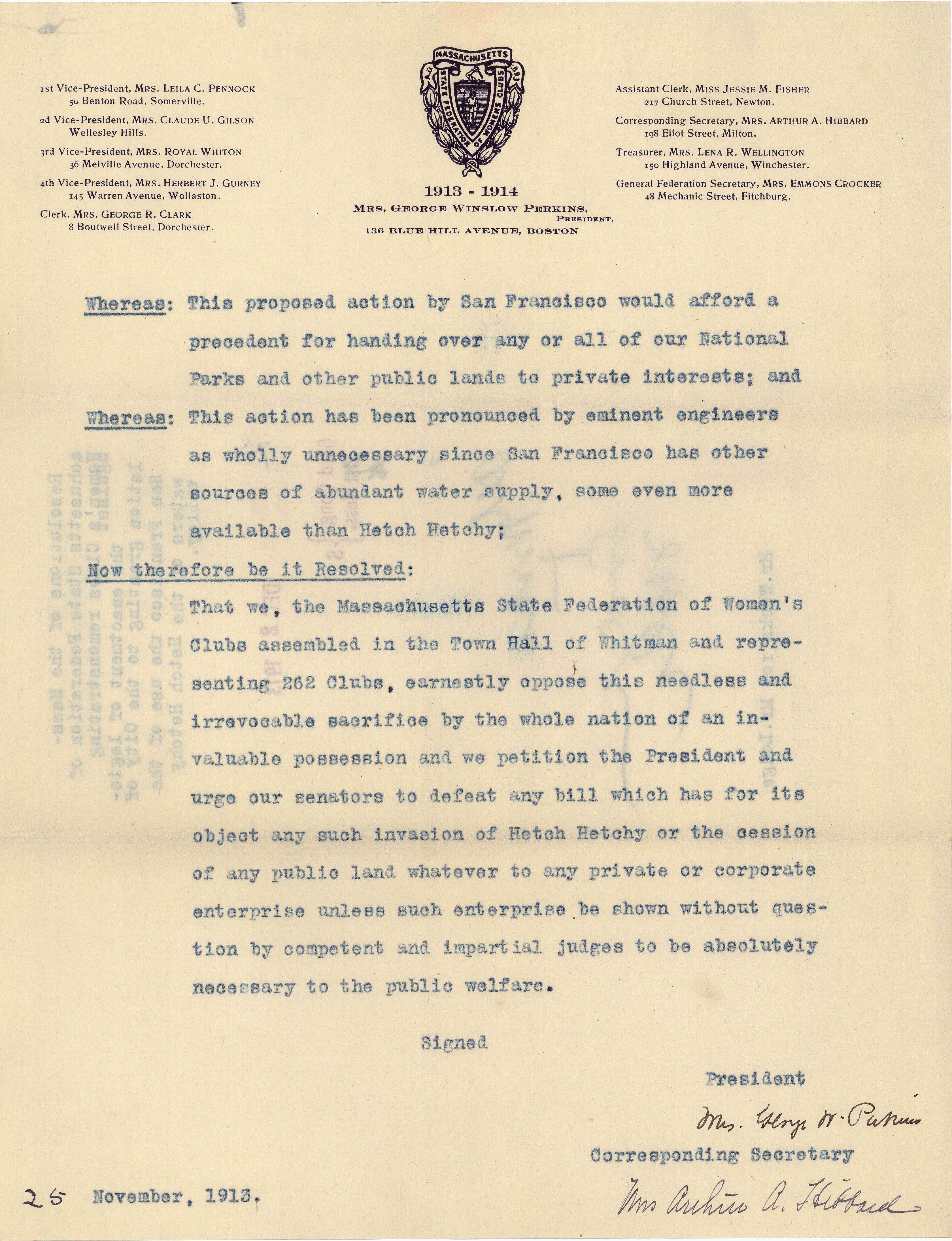
Document
Resolution from the Augusta, Hallowell, and Gardner Central Labor Union of Maine Supporting the Raker Bill
1913
Between 1908 and 1913, Congress debated whether to make a water resource available or preserve a wilderness when the growing city of San Francisco, California proposed building a dam in the Hetch Hetchy Valley to provide a steady water supply. The Hetch Hetchy Valley was within Yosemite National Park and protected by the federal government, leaving it up to Congress to decide the valley’s fate. National opinion divided between giving San Francisco the right to dam the valley and preserving the valley from development.
At the heart of the debate was the conflict between conservationists, who held that the environment should be used in a conscientious manner to benefit society, and preservationists, who believed that nature should be protected, saved from human interference. Siding with the conservationists, San Francisco citizens argued that the reservoir was necessary for the health of their city. On the other side, preservationists, led by John Muir, argued that Congress should protect the Hetch Hetchy Valley from destruction. Muir and his allies believed that nature should be enjoyed for its beauty, and not merely used for its resources.
Hundreds of individuals and organizations from across the country submitted petitions to Congress regarding the valley. These petitions, some of which are included below, bear witness to the birth of environmental activism as citizens weighed in, expressing multiple opinions about the proper use of National Park land and the relationship between local interests and national values.
In the end, Congress passed legislation that enabled the creation of a dam in the Hetch Hetchy Valley. President Woodrow Wilson signed the bill into law on December 19, 1913. Although the preservationists lost this battle, the damming of the Hetch Hetchy Valley raised public awareness about the importance of preserving nature, and helped justify the creation of the National Park Service in 1916.
Resolution from the Augusta, Hallowell, and Gardner Central Labor Union of Maine Supporting the Raker Bill
Page 1
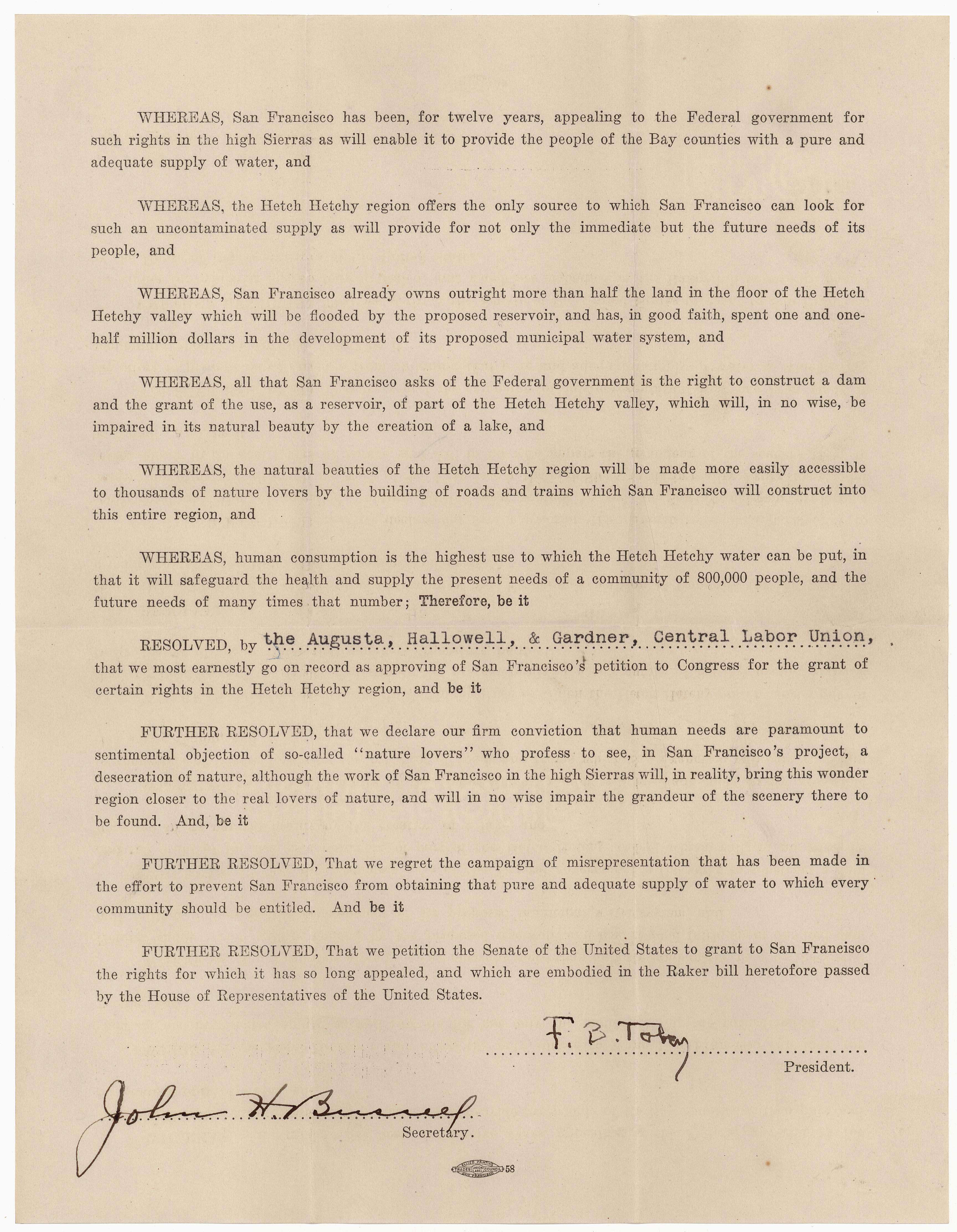
Document
Resolution from the Graffort Club of Portsmouth, New Hampshire, against Granting San Francisco the Hetch Hetchy Valley
2/4/1910
Between 1908 and 1913, Congress debated whether to make a water resource available or preserve a wilderness when the growing city of San Francisco, California proposed building a dam in the Hetch Hetchy Valley to provide a steady water supply. The Hetch Hetchy Valley was within Yosemite National Park and protected by the federal government, leaving it up to Congress to decide the valley’s fate. National opinion divided between giving San Francisco the right to dam the valley and preserving the valley from development.
At the heart of the debate was the conflict between conservationists, who held that the environment should be used in a conscientious manner to benefit society, and preservationists, who believed that nature should be protected, saved from human interference. Siding with the conservationists, San Francisco citizens argued that the reservoir was necessary for the health of their city. On the other side, preservationists, led by John Muir, argued that Congress should protect the Hetch Hetchy Valley from destruction. Muir and his allies believed that nature should be enjoyed for its beauty, and not merely used for its resources.
Hundreds of individuals and organizations from across the country submitted petitions to Congress regarding the valley. These petitions, some of which are included below, bear witness to the birth of environmental activism as citizens weighed in, expressing multiple opinions about the proper use of National Park land and the relationship between local interests and national values.
In the end, Congress passed legislation that enabled the creation of a dam in the Hetch Hetchy Valley. President Woodrow Wilson signed the bill into law on December 19, 1913. Although the preservationists lost this battle, the damming of the Hetch Hetchy Valley raised public awareness about the importance of preserving nature, and helped justify the creation of the National Park Service in 1916.
Resolution from the Graffort Club of Portsmouth, New Hampshire, against Granting San Francisco the Hetch Hetchy Valley
Page 1
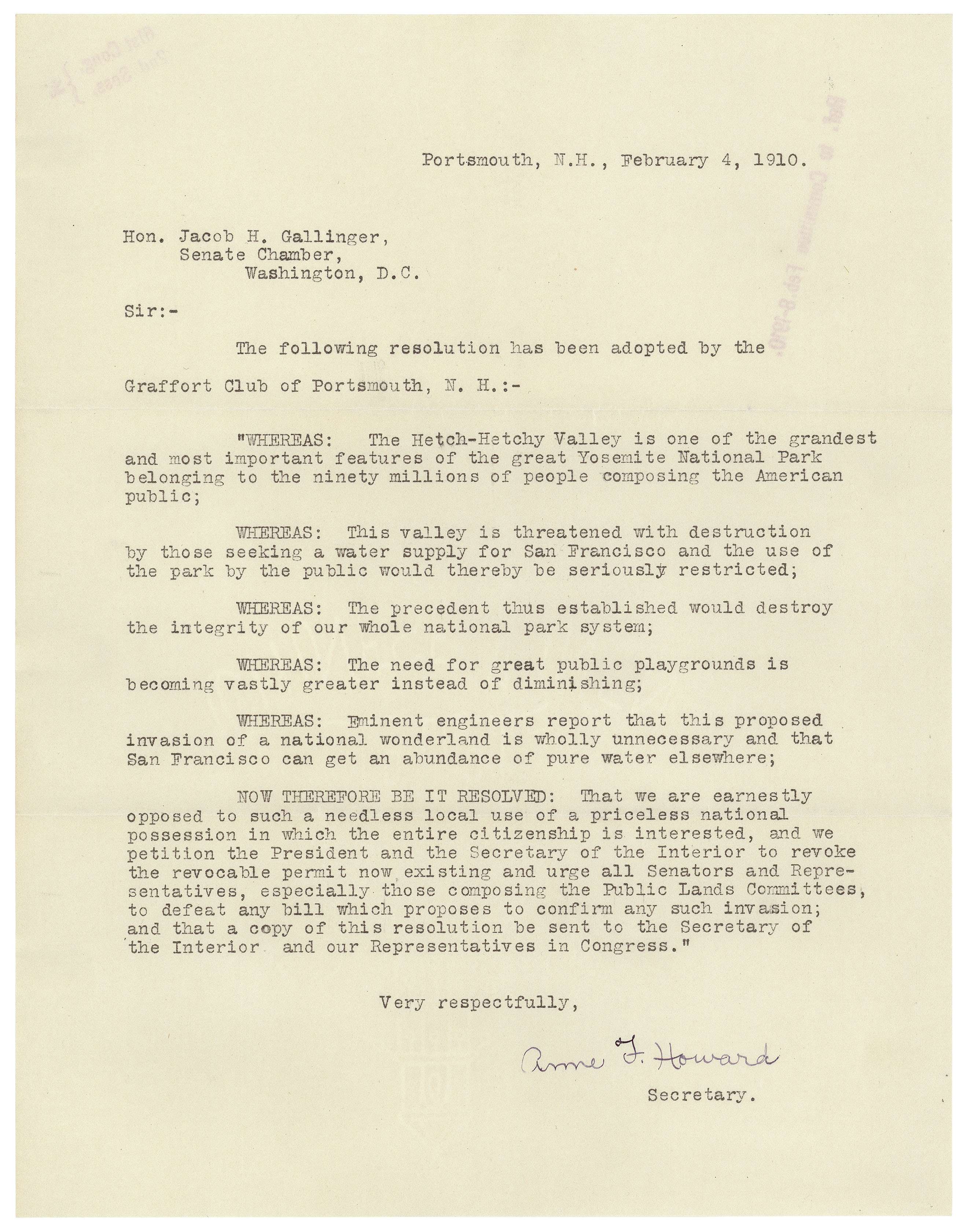
Document
Resolution, 'Protest Against Diversion of Waters from Lands Requiring Irrigation,' from Citizens of Merced and Stanislaus Counties, California
5/30/1913
Between 1908 and 1913, Congress debated whether to make a water resource available or preserve a wilderness when the growing city of San Francisco, California proposed building a dam in the Hetch Hetchy Valley to provide a steady water supply. The Hetch Hetchy Valley was within Yosemite National Park and protected by the federal government, leaving it up to Congress to decide the valley’s fate. National opinion divided between giving San Francisco the right to dam the valley and preserving the valley from development.
At the heart of the debate was the conflict between conservationists, who held that the environment should be used in a conscientious manner to benefit society, and preservationists, who believed that nature should be protected, saved from human interference. Siding with the conservationists, San Francisco citizens argued that the reservoir was necessary for the health of their city. On the other side, preservationists, led by John Muir, argued that Congress should protect the Hetch Hetchy Valley from destruction. Muir and his allies believed that nature should be enjoyed for its beauty, and not merely used for its resources.
Hundreds of individuals and organizations from across the country submitted petitions to Congress regarding the valley. These petitions, some of which are included below, bear witness to the birth of environmental activism as citizens weighed in, expressing multiple opinions about the proper use of National Park land and the relationship between local interests and national values.
In the end, Congress passed legislation that enabled the creation of a dam in the Hetch Hetchy Valley. President Woodrow Wilson signed the bill into law on December 19, 1913. Although the preservationists lost this battle, the damming of the Hetch Hetchy Valley raised public awareness about the importance of preserving nature, and helped justify the creation of the National Park Service in 1916.
Resolution, 'Protest Against Diversion of Waters from Lands Requiring Irrigation,' from Citizens of Merced and Stanislaus Counties, California
Page 1
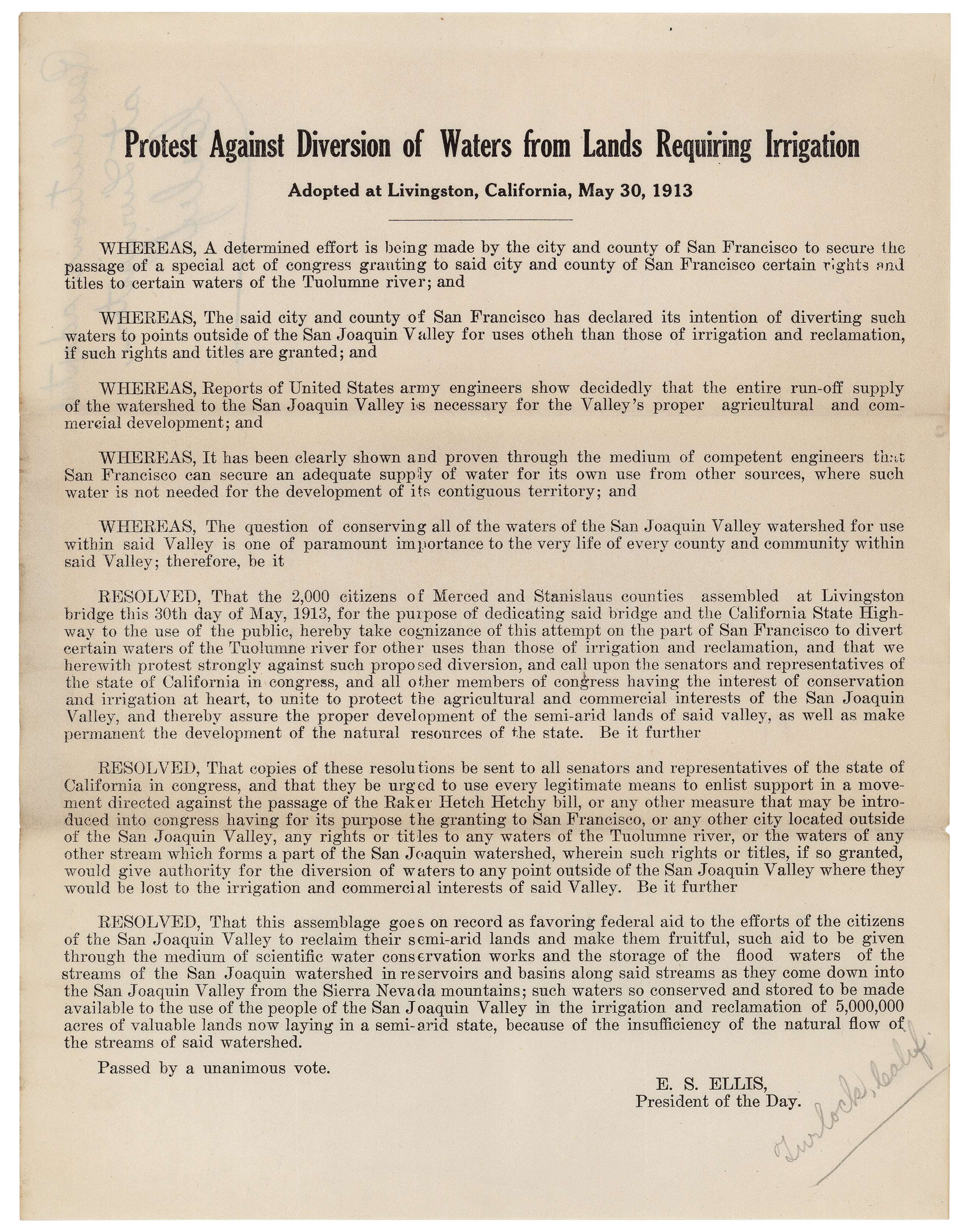
Document
San Francisco Examiner 'Petition to the Senate of the United States' Supporting the Raker Bill
1913
Between 1908 and 1913, Congress debated whether to make a water resource available or preserve a wilderness when the growing city of San Francisco, California proposed building a dam in the Hetch Hetchy Valley to provide a steady water supply. The Hetch Hetchy Valley was within Yosemite National Park and protected by the federal government, leaving it up to Congress to decide the valley’s fate. National opinion divided between giving San Francisco the right to dam the valley and preserving the valley from development.
At the heart of the debate was the conflict between conservationists, who held that the environment should be used in a conscientious manner to benefit society, and preservationists, who believed that nature should be protected, saved from human interference. Siding with the conservationists, San Francisco citizens argued that the reservoir was necessary for the health of their city. On the other side, preservationists, led by John Muir, argued that Congress should protect the Hetch Hetchy Valley from destruction. Muir and his allies believed that nature should be enjoyed for its beauty, and not merely used for its resources.
Hundreds of individuals and organizations from across the country submitted petitions to Congress regarding the valley. These petitions, some of which are included below, bear witness to the birth of environmental activism as citizens weighed in, expressing multiple opinions about the proper use of National Park land and the relationship between local interests and national values.
In the end, Congress passed legislation that enabled the creation of a dam in the Hetch Hetchy Valley. President Woodrow Wilson signed the bill into law on December 19, 1913. Although the preservationists lost this battle, the damming of the Hetch Hetchy Valley raised public awareness about the importance of preserving nature, and helped justify the creation of the National Park Service in 1916.
San Francisco Examiner 'Petition to the Senate of the United States' Supporting the Raker Bill
Page 1
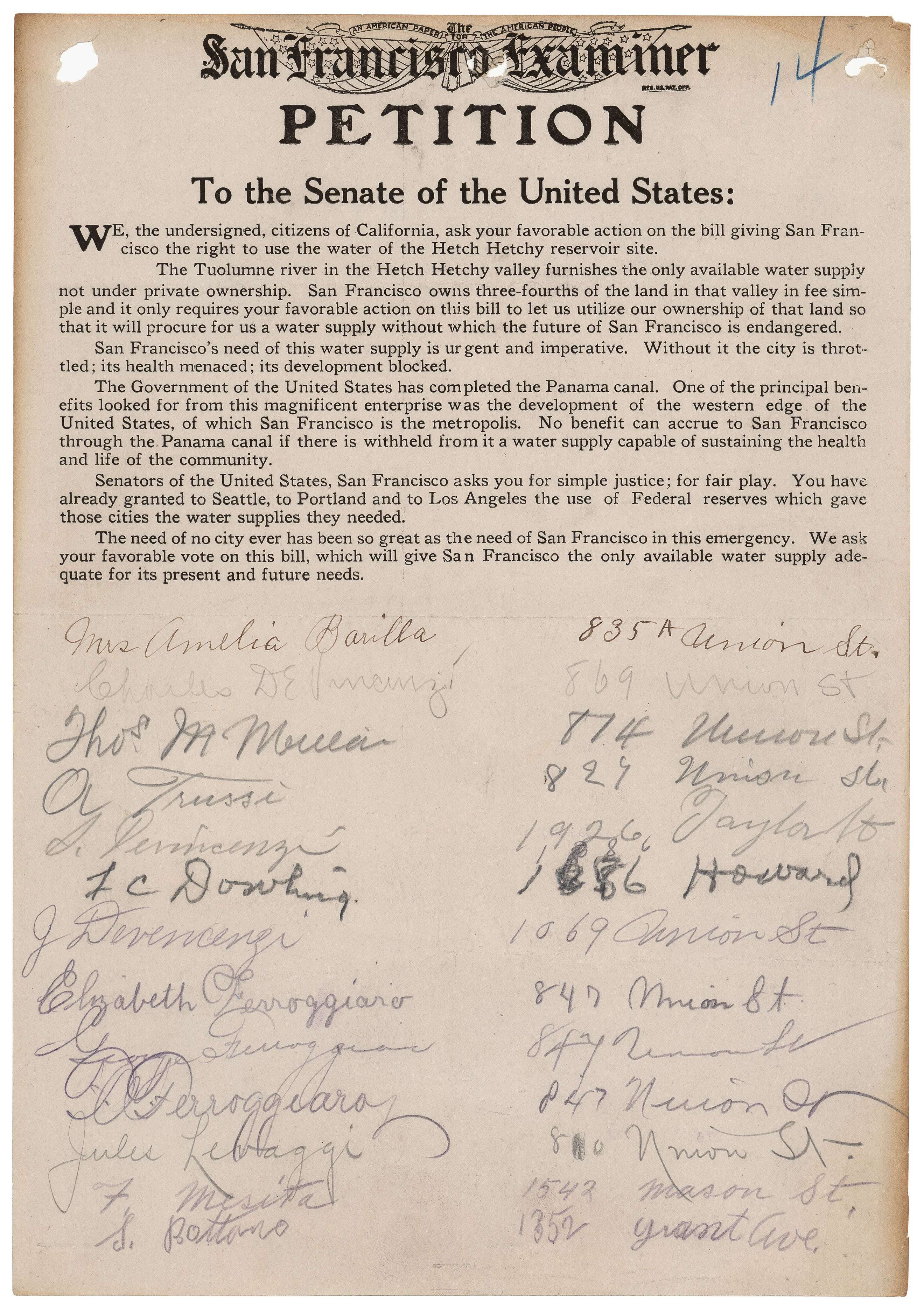
Document
Telegram from the San Francisco Council No. 615, Knights of Columbus, Supporting the Raker Bill
12/2/1913
Between 1908 and 1913, Congress debated whether to make a water resource available or preserve a wilderness when the growing city of San Francisco, California proposed building a dam in the Hetch Hetchy Valley to provide a steady water supply. The Hetch Hetchy Valley was within Yosemite National Park and protected by the federal government, leaving it up to Congress to decide the valley’s fate. National opinion divided between giving San Francisco the right to dam the valley and preserving the valley from development.
At the heart of the debate was the conflict between conservationists, who held that the environment should be used in a conscientious manner to benefit society, and preservationists, who believed that nature should be protected, saved from human interference. Siding with the conservationists, San Francisco citizens argued that the reservoir was necessary for the health of their city. On the other side, preservationists, led by John Muir, argued that Congress should protect the Hetch Hetchy Valley from destruction. Muir and his allies believed that nature should be enjoyed for its beauty, and not merely used for its resources.
Hundreds of individuals and organizations from across the country submitted petitions to Congress regarding the valley. These petitions, some of which are included below, bear witness to the birth of environmental activism as citizens weighed in, expressing multiple opinions about the proper use of National Park land and the relationship between local interests and national values.
In the end, Congress passed legislation that enabled the creation of a dam in the Hetch Hetchy Valley. President Woodrow Wilson signed the bill into law on December 19, 1913. Although the preservationists lost this battle, the damming of the Hetch Hetchy Valley raised public awareness about the importance of preserving nature, and helped justify the creation of the National Park Service in 1916.
Telegram from the San Francisco Council No. 615, Knights of Columbus, Supporting the Raker Bill
Page 1
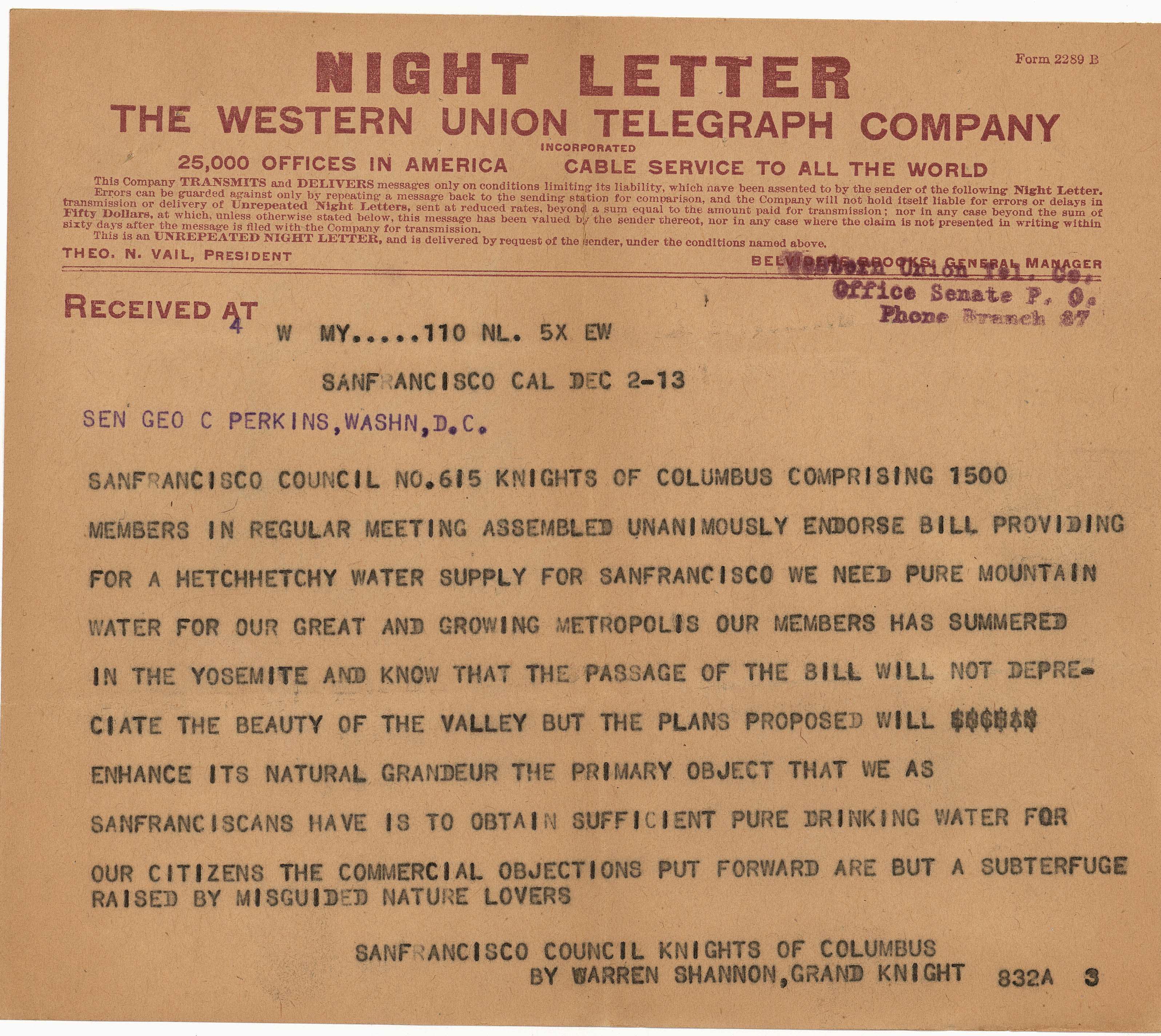
Document
Telegram from the Executive Board of the San Francisco District of the California Federation of Women's Clubs Supporting the Raker Bill
12/2/1913
Between 1908 and 1913, Congress debated whether to make a water resource available or preserve a wilderness when the growing city of San Francisco, California proposed building a dam in the Hetch Hetchy Valley to provide a steady water supply. The Hetch Hetchy Valley was within Yosemite National Park and protected by the federal government, leaving it up to Congress to decide the valley’s fate. National opinion divided between giving San Francisco the right to dam the valley and preserving the valley from development.
At the heart of the debate was the conflict between conservationists, who held that the environment should be used in a conscientious manner to benefit society, and preservationists, who believed that nature should be protected, saved from human interference. Siding with the conservationists, San Francisco citizens argued that the reservoir was necessary for the health of their city. On the other side, preservationists, led by John Muir, argued that Congress should protect the Hetch Hetchy Valley from destruction. Muir and his allies believed that nature should be enjoyed for its beauty, and not merely used for its resources.
Hundreds of individuals and organizations from across the country submitted petitions to Congress regarding the valley. These petitions, some of which are included below, bear witness to the birth of environmental activism as citizens weighed in, expressing multiple opinions about the proper use of National Park land and the relationship between local interests and national values.
In the end, Congress passed legislation that enabled the creation of a dam in the Hetch Hetchy Valley. President Woodrow Wilson signed the bill into law on December 19, 1913. Although the preservationists lost this battle, the damming of the Hetch Hetchy Valley raised public awareness about the importance of preserving nature, and helped justify the creation of the National Park Service in 1916.
Telegram from the Executive Board of the San Francisco District of the California Federation of Women's Clubs Supporting the Raker Bill
Page 2
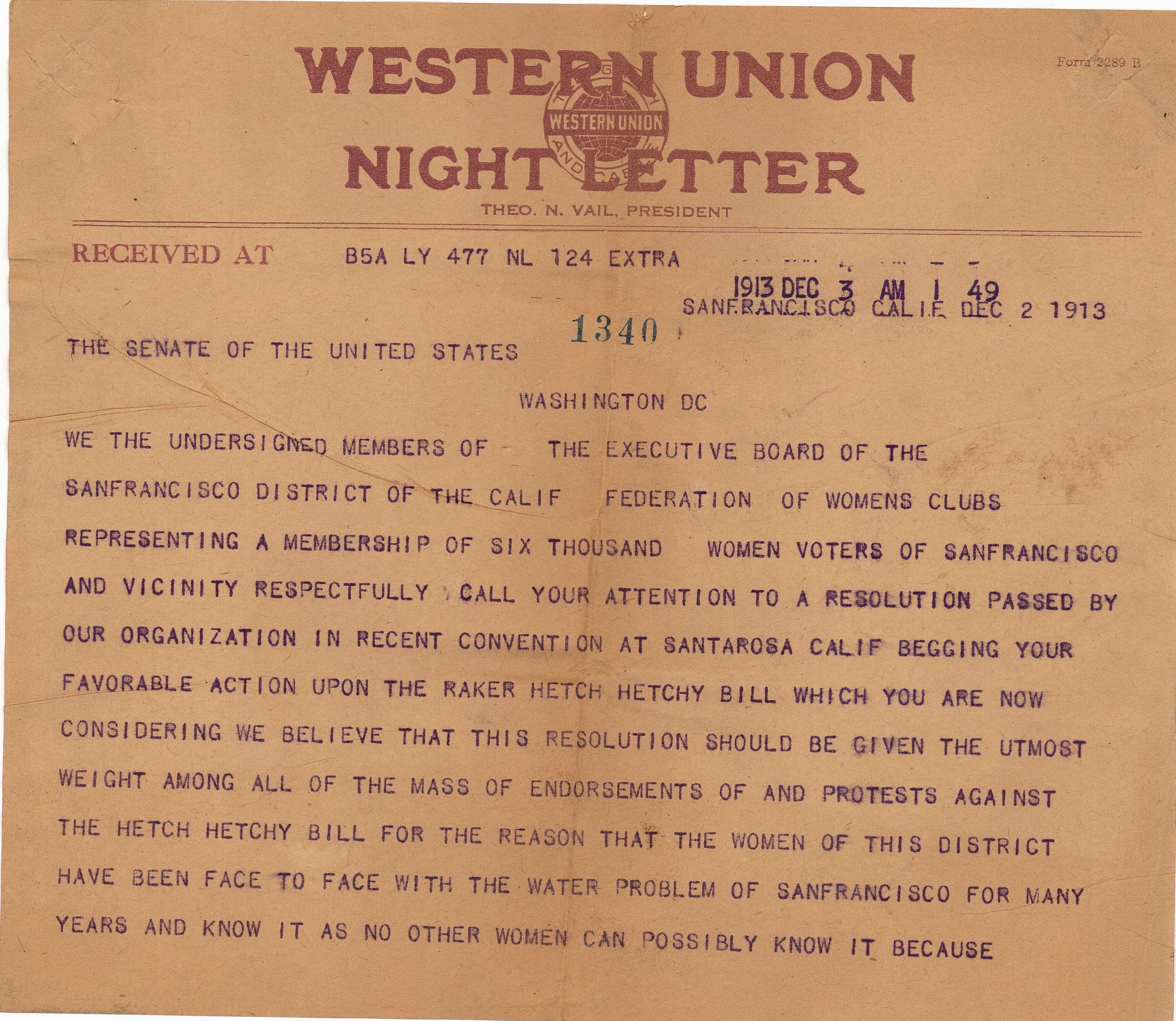
Telegram from the Executive Board of the San Francisco District of the California Federation of Women's Clubs Supporting the Raker Bill
Page 3
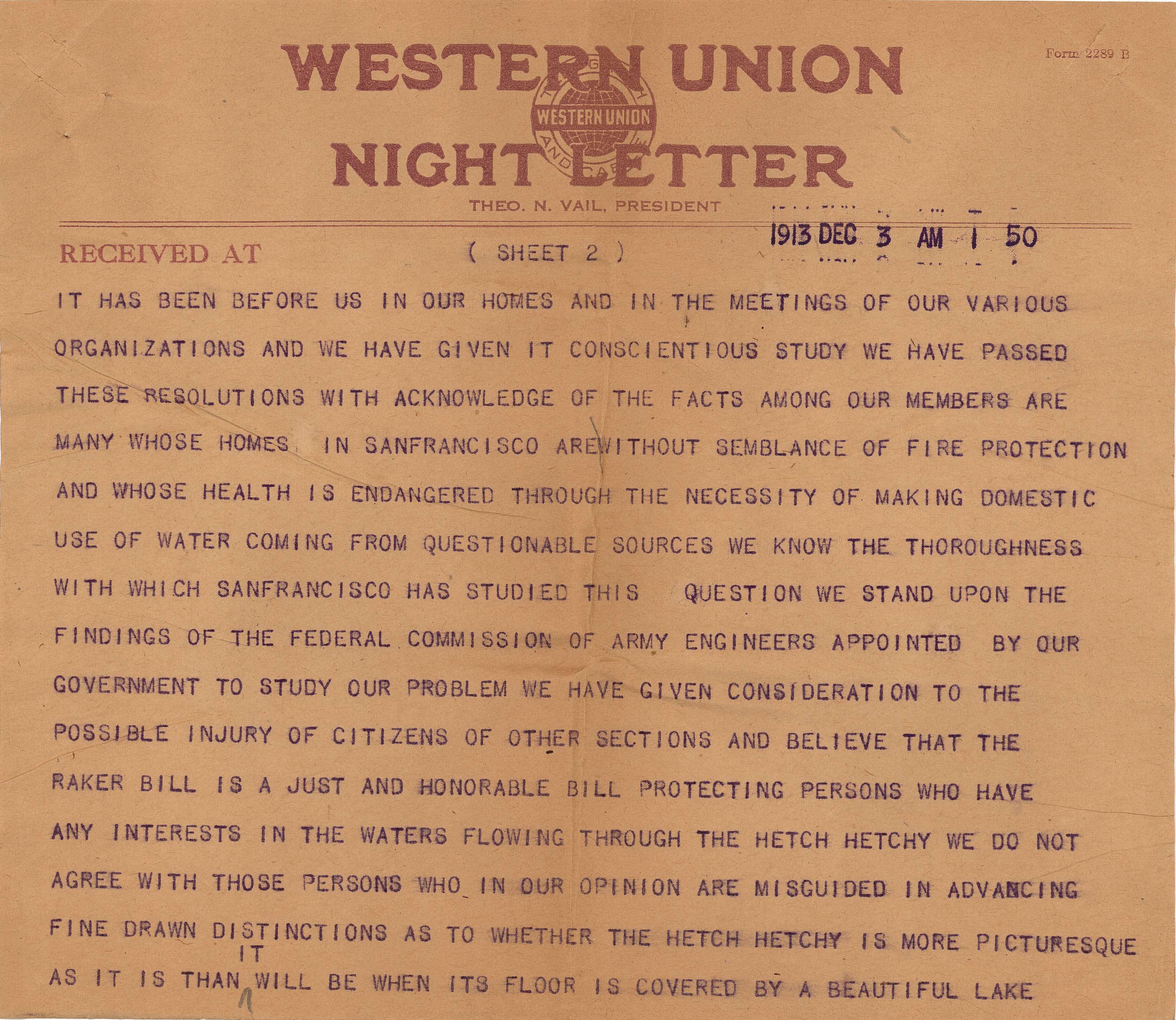
Telegram from the Executive Board of the San Francisco District of the California Federation of Women's Clubs Supporting the Raker Bill
Page 4
